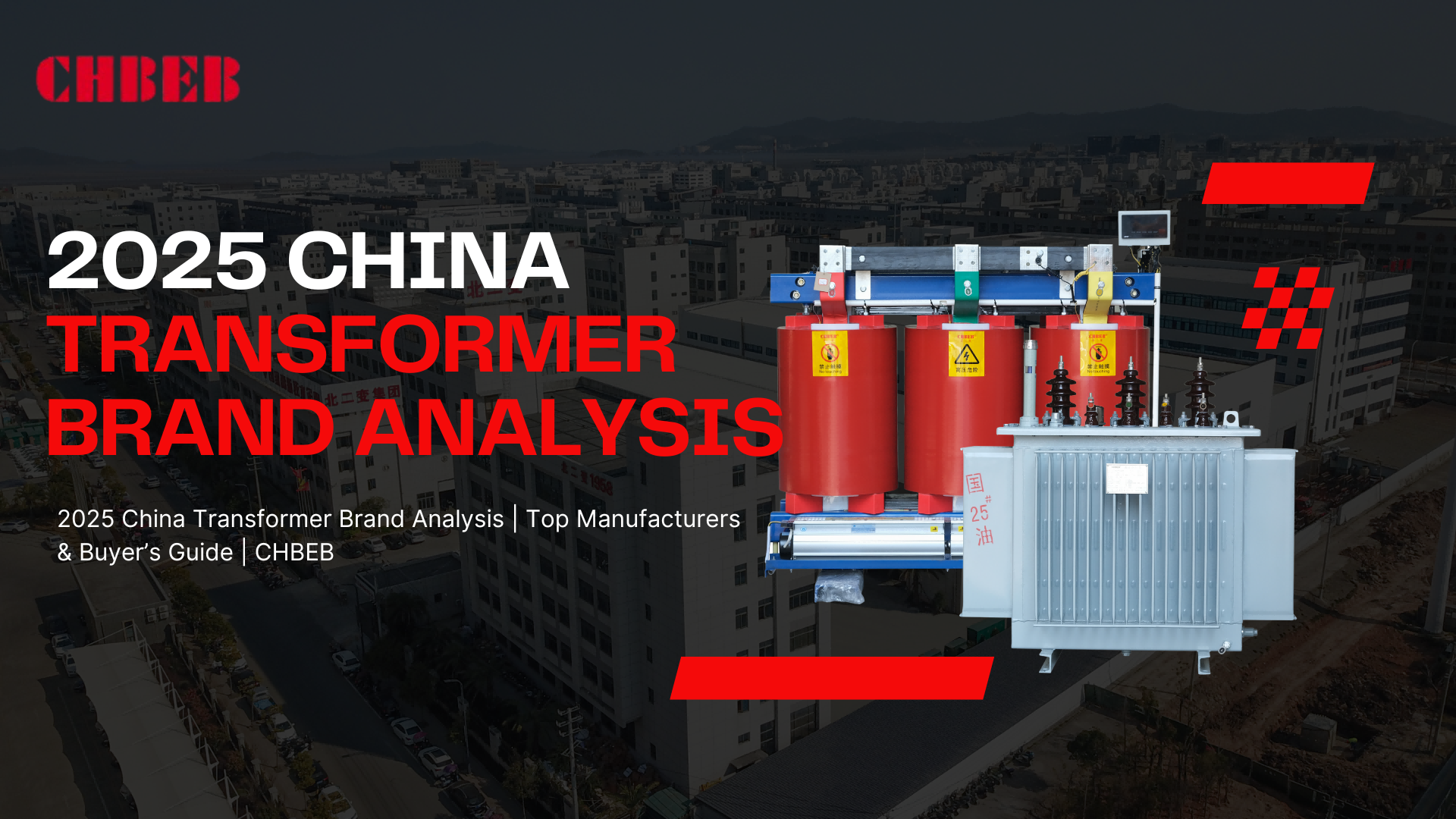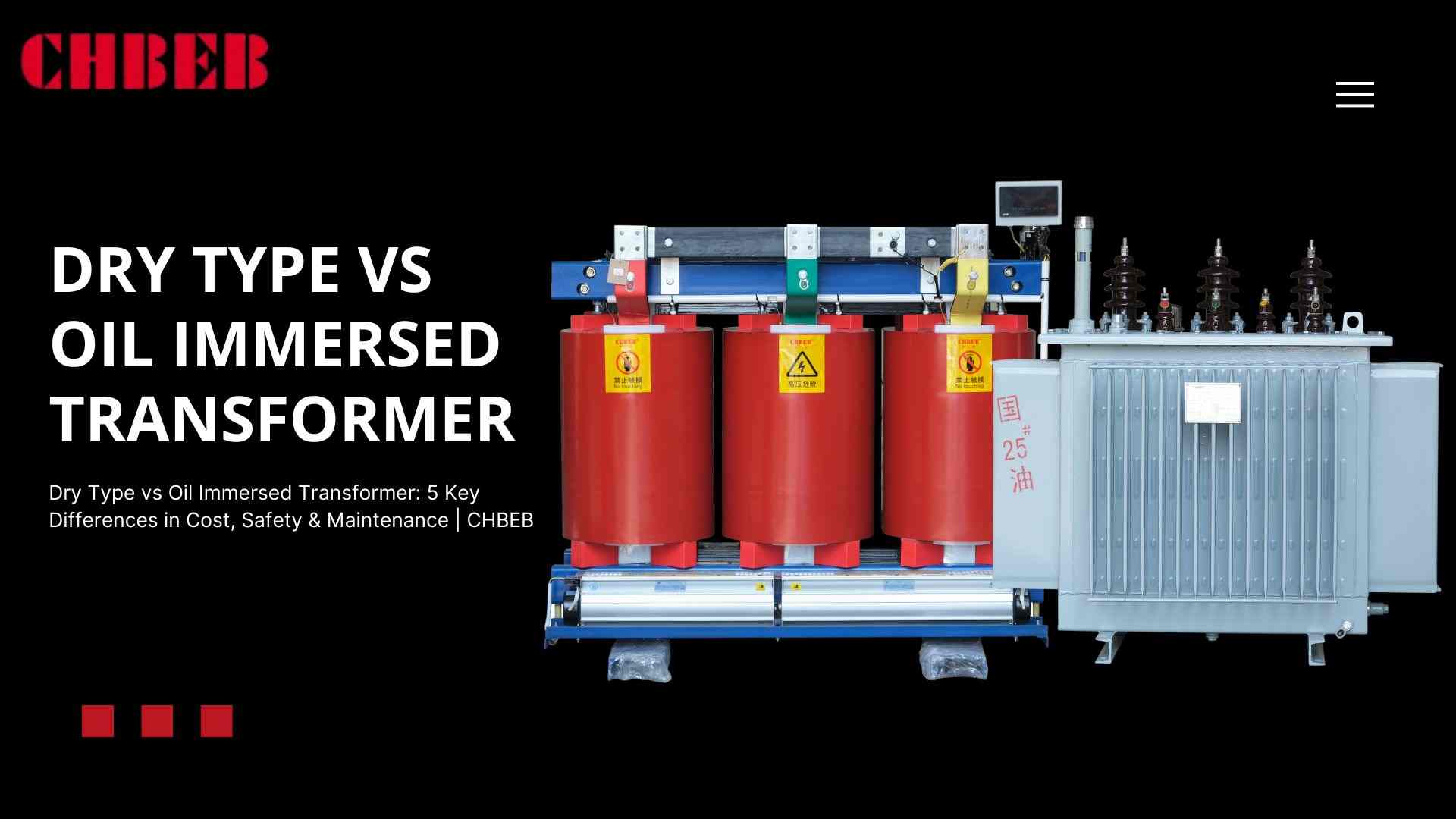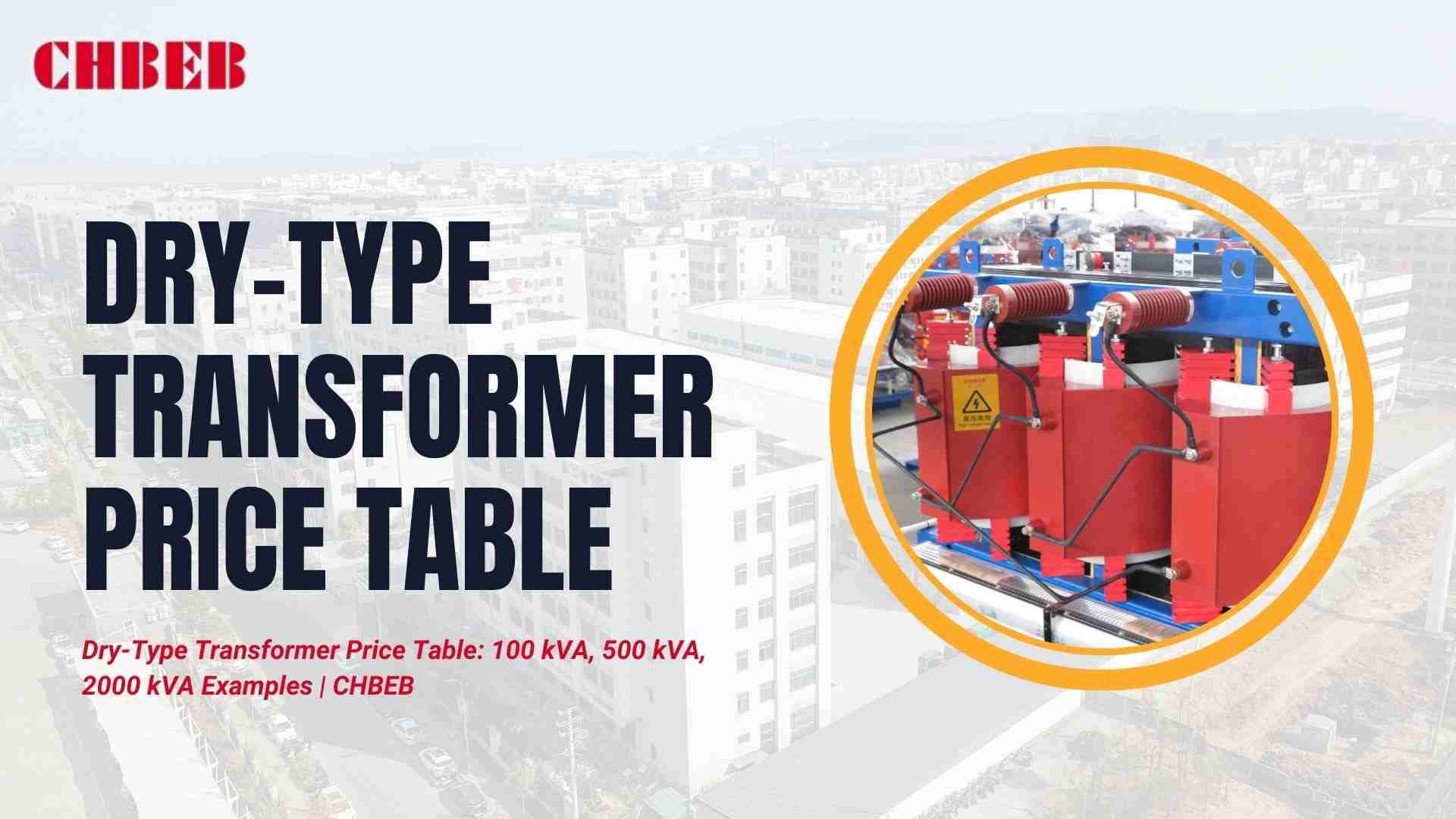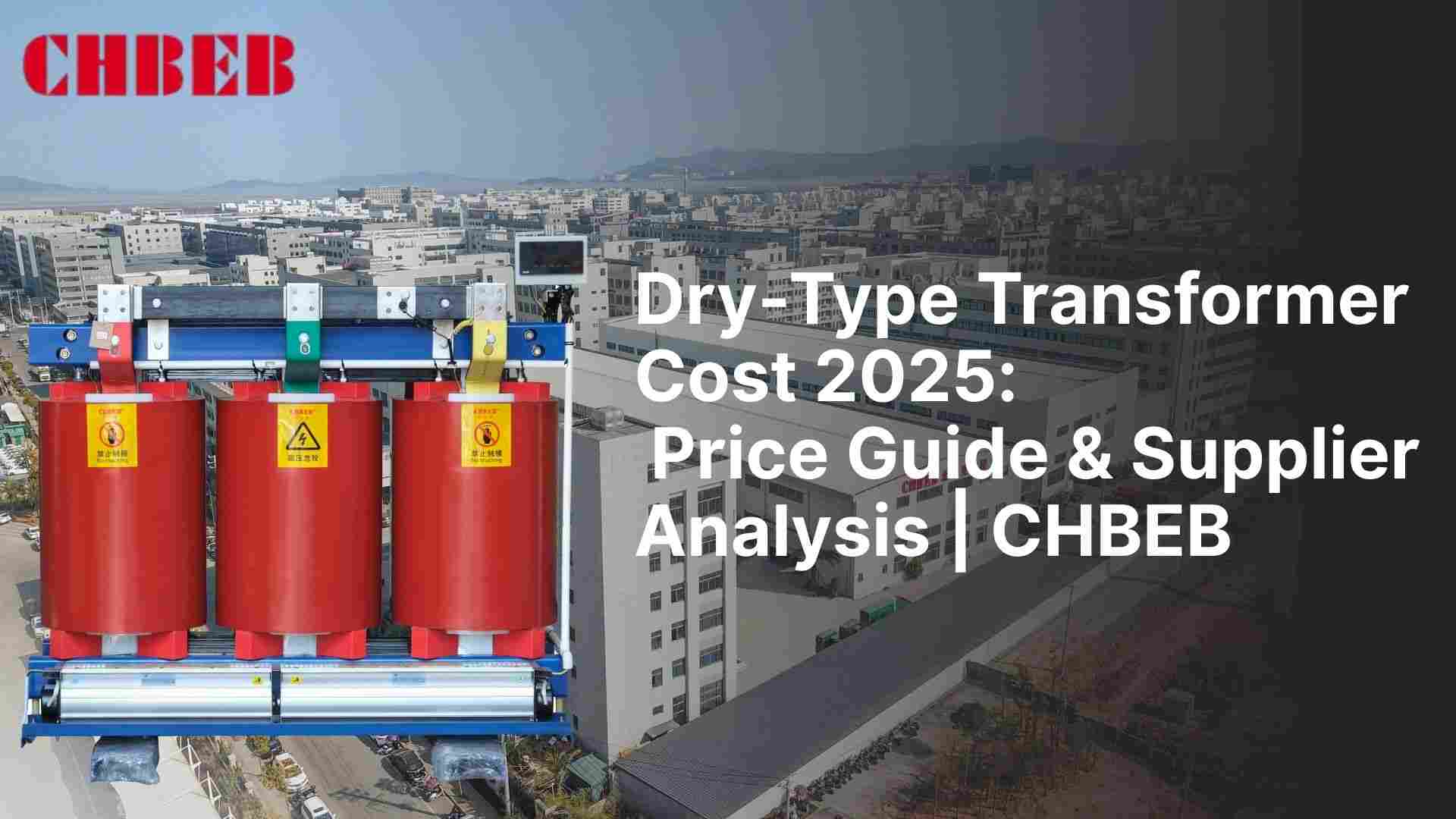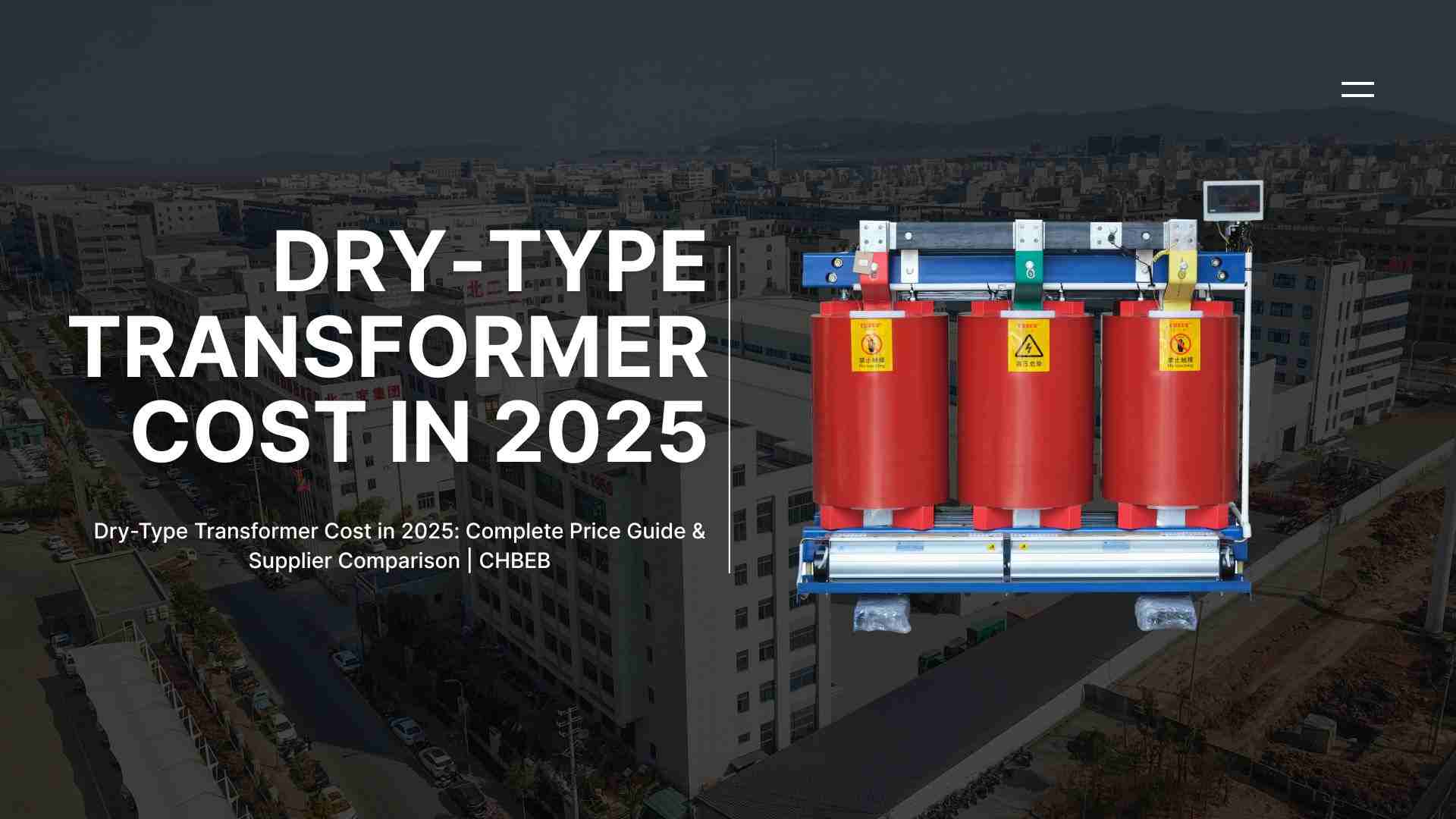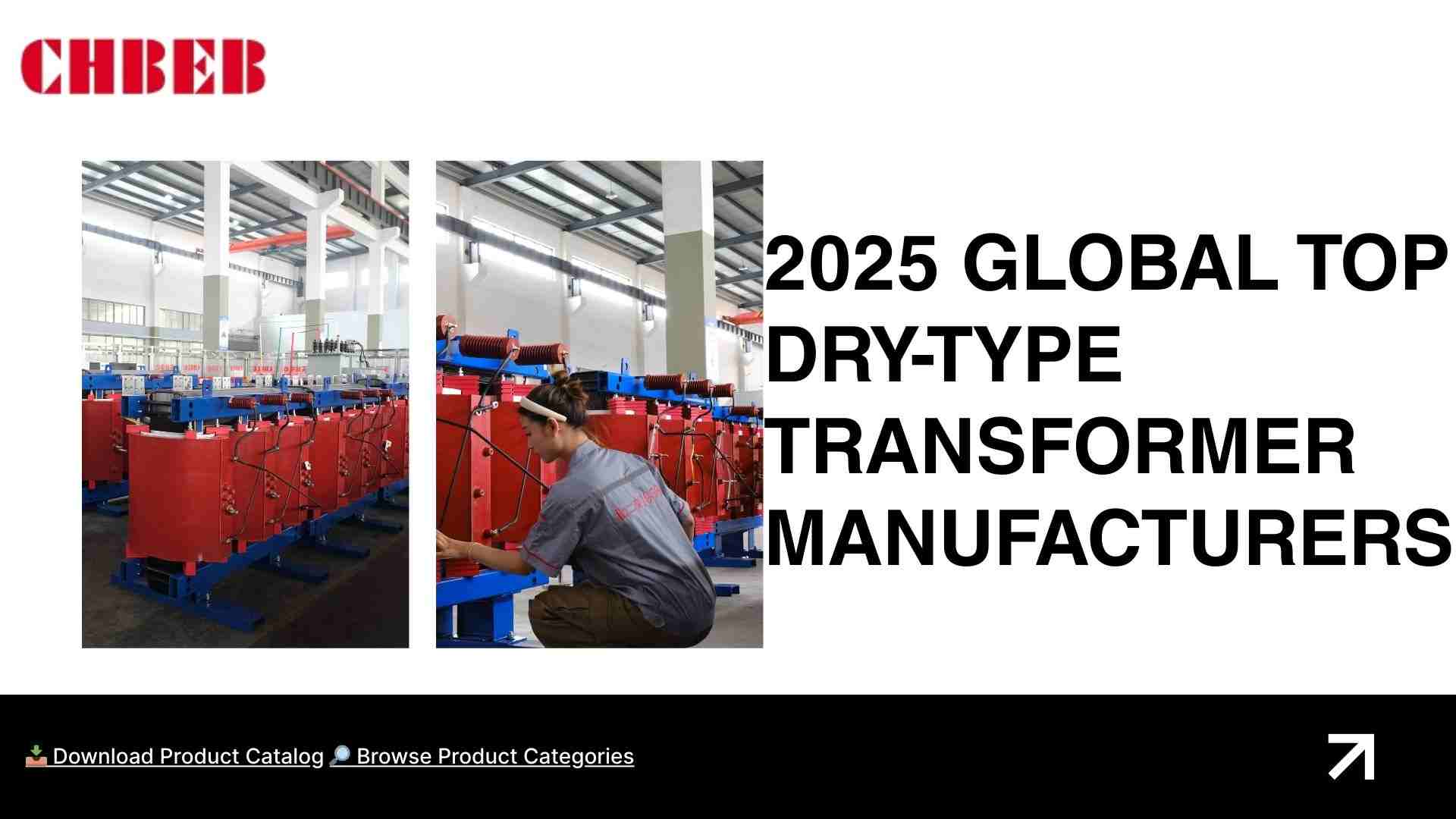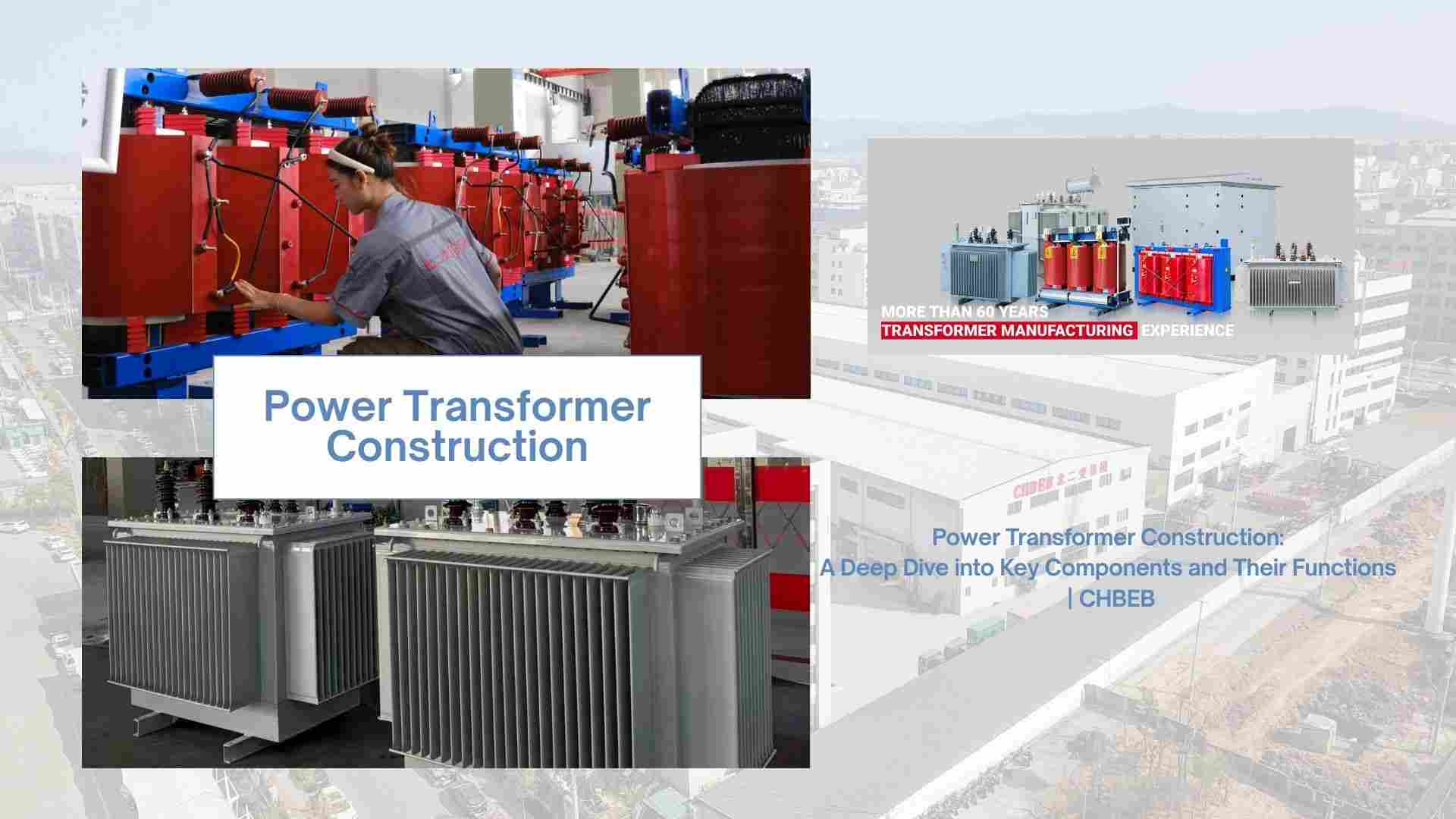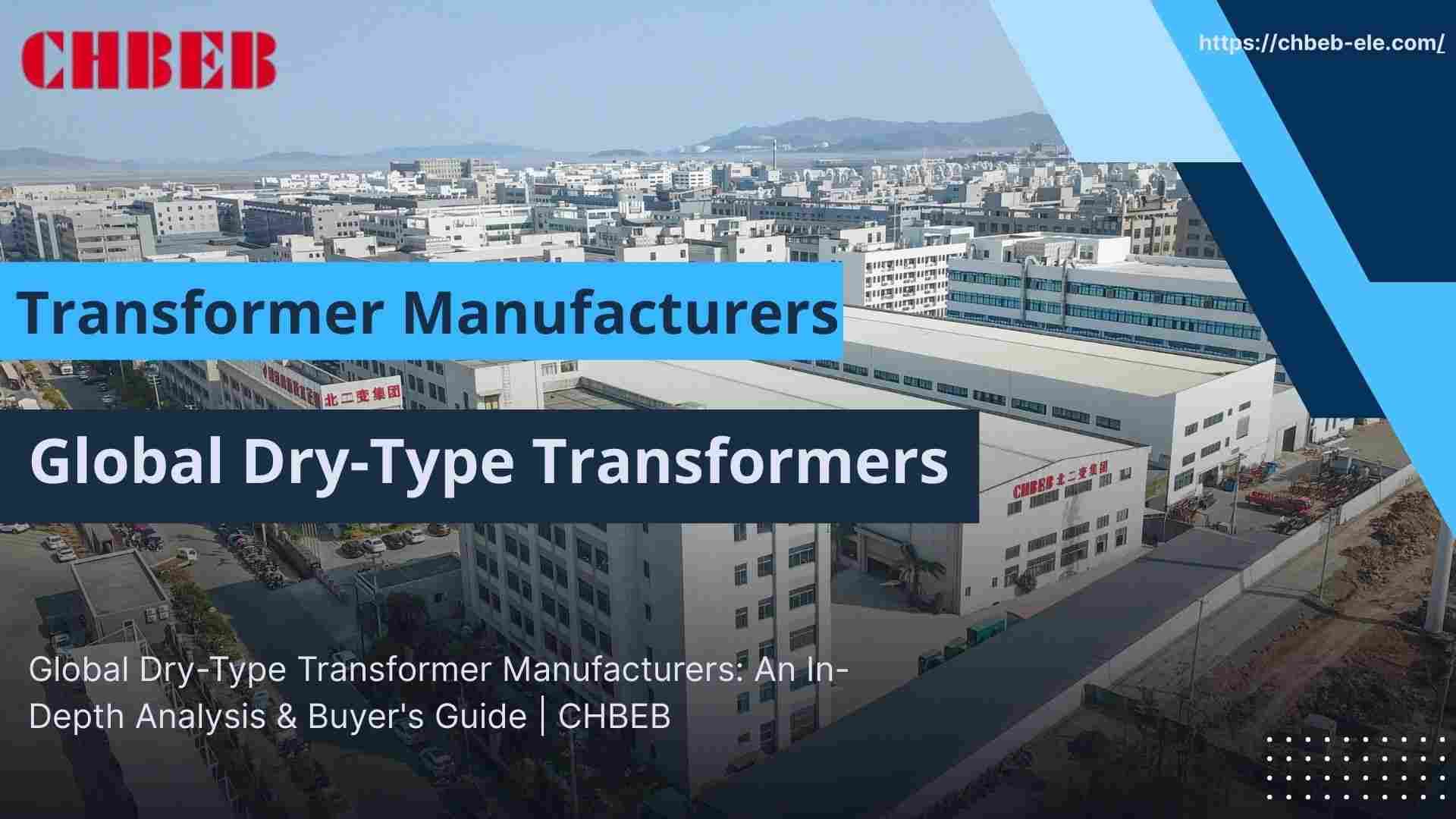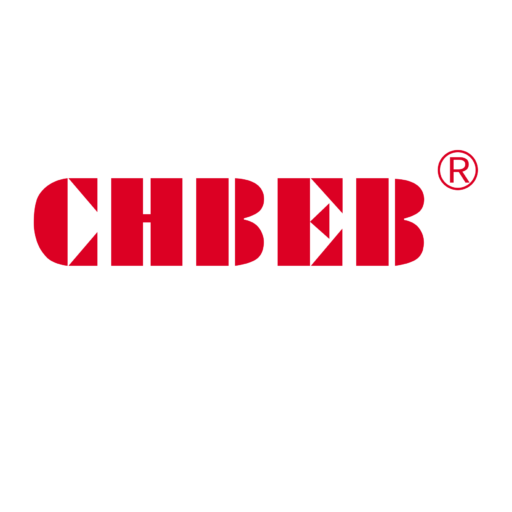Introduction
If you choose the wrong transformer, you could end up with overloads, voltage drops, and expensive downtime. A lot of purchasers have trouble with kVA, starting variables, and picking the right materials. This guide goes over the basics so you can choose the right transformer size and design for your project.
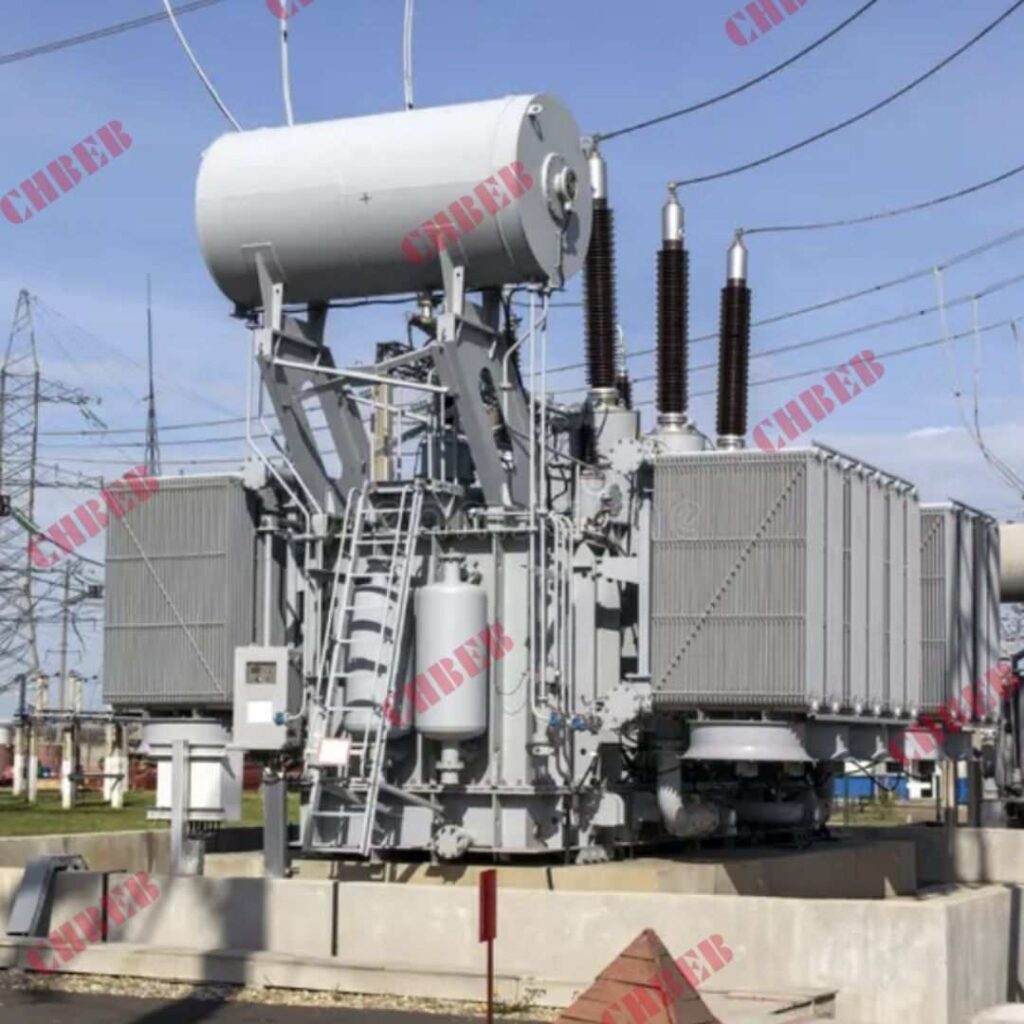
Transformer Capacity Basics: What kVA and the Starting Factor Mean
People commonly mix up kVA and kW or forget how much power a motor needs to start. This causes units to be too small and to break down. Before making decisions about materials or costs, you need to know the basics of capacity.
What do kVA and kW1 mean? Why do we rate transformers in kVA?
Transformers are rated in kVA (kilovolt-ampere) instead of kW since they give off both active power (kW) and reactive power (kVAR). Power factor (PF) determines how much power can be used.
- The formula for kW is kVA × PF.
- For instance, a 100 kVA transformer with a 0.8 PF gives forth 80 kW of real power.
Transformers are always rated in kVA since the power factor (PF) changes depending on the kind of load (motors, lighting, electronics).

Formulas for calculating the kVA of a transformer (single-phase and three-phase)
If you don’t use formulas, you could end up with too big or too small of a size, which could be dangerous. The answer is to use the proper formula for each situation.
- Single-phase: kVA=V×I1000kVA = \frac{V × I}{1000}kVA=1000V×I Example: 240 V × 100 A = 24,000 VA = 24 kVA
- Three-phase: kVA=3×V×I1000kVA = \frac{\sqrt{3} × V × I}{1000}kVA=10003×V×I Example: 415 V × 100 A × 1.732 = 71,800 VA = 71.8 kVA

What is a factor that starts? How to Figure Out How Much kVA You Need to Start a Motor
Underrated designs break down when motors start up, when the inrush might be 4–7 times the entire load current. To figure out the kVA of a transformer, you need to use a beginning factor.
- kVAneeded = MotorHP × 0.746Efficiency × PF × Starting Factor kVA_{required} = Motor HP × 0.746{Efficiency × PF} × Starting FactorkVAneeded=Efficiency×PFMotorHP × 0.746 × Starting Factor
- For a reliable starter, a 75 HP motor with 0.9 efficiency, 0.85 PF, and 6× inrush needs a transformer with a capacity of about 440 kVA.
Case Study: How to Figure Out the Total Load and Transformer Capacity for an Industrial Workshop
A workshop has:
- 2 × 50 HP motors
- 1 × 30 HP motor
- Lighting load 20 kW
Step 1: Convert motor HP to kW
- 50 HP = 37.3 kW × 2 = 74.6 kW
- 30 HP = 22.4 kW
- Lighting = 20 kW
- Total = 117 kW
Step 2: Use PF (0.85) and Efficiency (0.9) 117 ÷ (0.85 × 0.9) = 153 kVA
Step 3: Add a starting factor for motors (with a safety margin of ×1.25)
Final transformer capacity needed is about 190 kVA.
Result: Pick a 200 kVA transformer to handle the starting and load g
Balancing Performance & Cost: Choosing Winding Material & Cooling Method
A lot of buyers pay too much for copper or don’t think about how much cooling they need. Both errors raise costs or shorten the life of the product. The best way to get the right balance is to look at winding and cooling simultaneously.
A Close Look at the Pros, Cons, and Costs of Copper and Aluminum Windings
- Windings of copper
- More conductivity means less loss.
- Smaller size, better in handling overloads
- More expensive at first
- Windings made of aluminum
- Less expensive, lighter
- Needs bigger cross-sections to match copper
- Losses that are a little higher
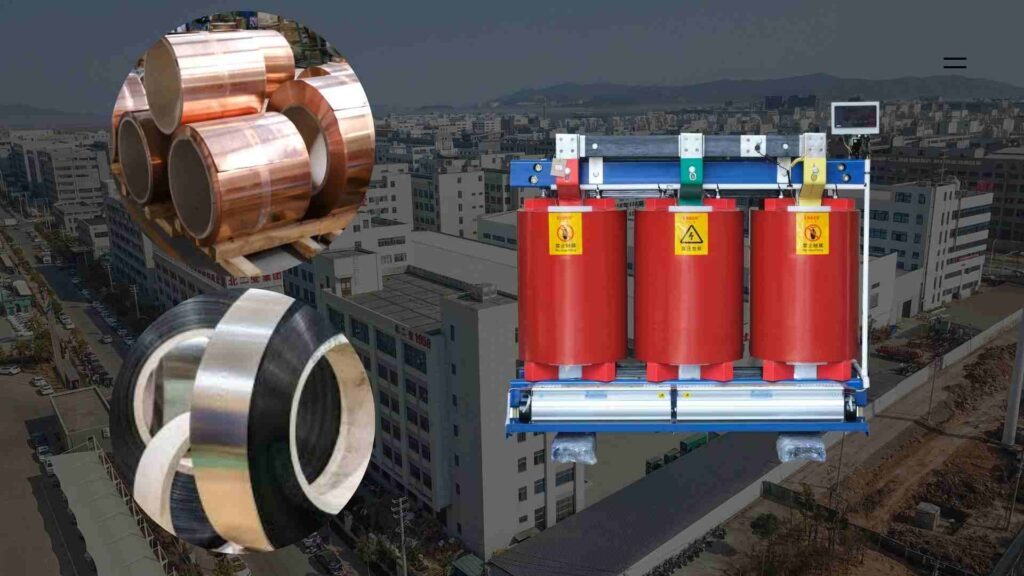
Comparison Table
| Factor | Copper | Aluminum |
|---|---|---|
| Conductivity | High | ~61% of copper |
| Size & Weight | Smaller, heavier density | Larger, lighter metal |
| Cost | Higher | Lower |
| Durability | Superior | Good with modern alloys |
| Best Fit | Critical/continuous loads | Cost-sensitive projects |
A Full Guide to Transformer Cooling: Natural vs. Forced, Dry-Type vs. Oil-Immersed
Mistakes in cooling might lead to overheating and insulation failure. The answer is to match the type of cooling to the conditions at the site.
- Dry-Type Transformers
- Air cooling (natural or forced)
- Safer indoors, higher cost, lower ratings
- Oil-Immersed Transformers
- Mineral oil or ester fluid
- Efficient cooling, outdoor use, fire precautions needed
Cooling Methods:
- ONAN stands for “Oil Natural Air Natural.”
- ONAF (Oil Natural Air Forced)
- Oil Directed Air Forced (ODAF)
- AN/AF (Air Natural/Air Forced for dry types)
How to Choose the Best Material and Cooling Method for Your Needs
Hospital or high-rise building inside? Pick the dry variety with copper windings.
Substation or renewable farm outside? Choose oil with aluminum in it (this is the cheapest option).
Heavy industry with burdens that don’t stop? Copper + oil for the best durability.
Ensuring Long-Term Reliability: Other Critical Selection Factors
A lot of purchasers only look at kVA and material. Not taking into account power factor, voltage, and the environment might cause early failures. The answer is to think about important details that were missed.
The Importance of Power Factor and How to Fix It
Bad PF equals wasted space and fines. Using capacitor banks or active filters to fix things makes transformers smaller, lowers losses, and makes the system work better.
Ambient Conditions, Voltage, and Losses: The Details That Are Often Missed When Choosing
- High temperatures necessitate derating.
- Altitude: More over 1000 m makes cooling less effective.
- Voltage Changes: Make sure the tap changer range meets the stability of the grid.
- Losses: Ask for guaranteed no-load/load losses; these add to the cost of energy over time.
Your FAQs and Transformer Selection Checklist
List of things to do:
- ✔ Figure out kVA (beginning factors included)
- ✔ Check PF and make any necessary changes
- ✔ Pick between aluminum and copper windings
- Choose cooling based on the conditions at the place.
- ✔ Think about the weather: the temperature, the height, and the humidity
- ✔ Look for IEC, ANSI, and GB certifications.
- ✔ Compare capital expenditures to operating expenses during the life of the project
Questions and Answers:
- Why do we rate transformers in kVA instead of kW? This is because they give both active and reactive power.
- Copper windings are cheaper than aluminum windings, but aluminum is bigger.
- Which lasts longer, dry type or oil immersed? With the right care, oil-immersed things usually endure longer.
Conclusion
Choosing the right transformer is not just about picking a size off the shelf—it requires a structured approach.
- Start with capacity: Calculate the kVA correctly, including motor starting factors, to prevent overloads and hidden downtime costs.
- Balance materials and cooling: Copper vs. aluminum windings2 and dry-type vs. oil-immersed designs should be chosen based on application, cost targets, and safety needs.
- Account for operating conditions: Power factor, temperature, altitude, and guaranteed loss values directly impact lifetime performance and energy costs.
- Think lifecycle, not just purchase price: Compare CAPEX with OPEX over 20–30 years to secure the best ROI.
✅ Final takeaway: The best transformer is the one that matches your kVA demand, starting profile, and site environment, while balancing safety, performance, and cost. A well-specified design ensures reliable operation and long-term savings.
Learn More
Looking for the right dry-type transformer for your project? Download our latest product catalog or browse our product categories to find reliable solutions tailored to your needs.
Introduction
Picking the wrong brand could mean lost time and money. China’s market is busy and moves quickly, which makes things even more confusing. With proven market drivers, objective brand profiles, and a useful decision framework, this book helps you limit down your options.
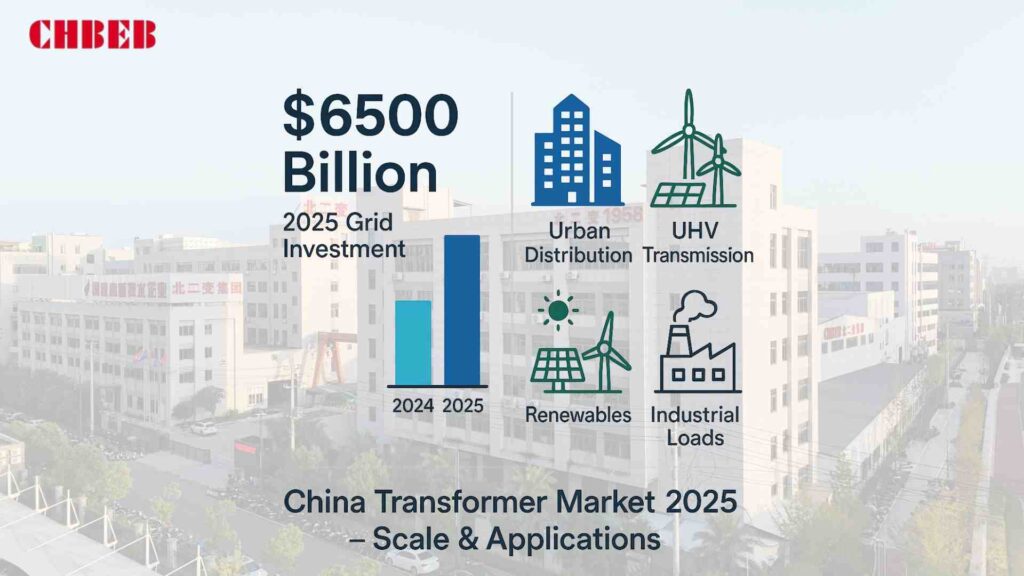
Part 1: The Market Landscape and Important Brand Profiles
An overview of the China Transformer Market and its main drivers in 2025
When planners neglect structural drivers, projects come to a halt. If you don’t spend enough in the grid and renewables, you can end up with old specs. The solution is to base choices on demand indications from 2025.
- State Grid1 aims to invest more than ¥650 billion (~$88.7 billion) in 2025 to improve transmission and distribution. This is after spending more in 2024. Reuters
- Explosive Renewables: In 2025, China installed more than 1,000 GW of solar power, which made the need for high-reliability grid and step-up transformers even greater. The Magazine for Transformers
- UHV Build-out: Ongoing UHV AC/DC corridors, including mixed-energy lines for new-energy bases, keep HV/EHV transformers in focus. People’s Daily
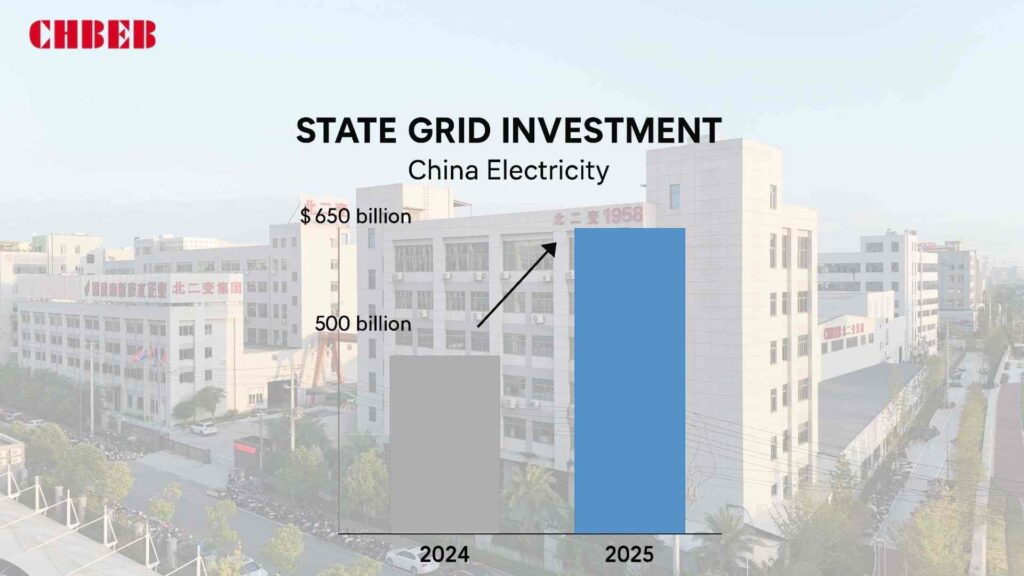
What it means: Specifications are moving toward fewer losses, greater ratings, digital monitoring, and being ready for UHV/HVDC.
Market Leaders: The Big Companies in the U.S. That Are Running National Projects
Choosing vendors that are too small can cause delays. If you don’t pay attention to national winners, you miss out on proven UHV capacity and auction victories. Solution: create a list of state-linked and big private leaders with proven scale.
- China XD2 Group is a state-owned company that makes transformers up to 1100 kV and has large research and development and testing labs. It is the main supplier for UHV/GRID projects.
- TBEA is a major player in UHV/HVDC and a supplier to the State Grid for both transmission and integrating renewables (a lot of people in the China market talk about them). Mordor Intelligence
- Baoding Tianwei Baobian Electric makes large-scale power and UHV AC/DC transformers. It is listed in Shanghai and has been in business for a long time in the >500 kV segments.
- JSHP Transformer is a major exporter of power transformers (up to hundreds of MVA) with a significant global presence and exports.
Why they are in the lead: their capacity, their experience with domestic projects, and their ability to bid on State Grid/CSG projects, which will continue in 2025. news.metal.com
Technology and the High-End Market: The Big Companies in China
If you think “foreign = always better,” you’re wasting money; if you don’t, you could lose efficiency over time. It’s important to find a balance.
- Siemens Energy offers high-end power and dry-type portfolios, as well as digital services. They are also still investing in transformer capacity.
- Hitachi Energy (previously ABB Power Grids) works with several partners in China to use HVDC/dry-type and eco-friendly technology.
- GE Vernova (Grid Solutions) is a company that makes grid equipment and transformers for renewable energy and transmission projects.
- Schneider Electric and Mitsubishi Electric are major players in the Chinese market, especially in distribution and industrial transformers and advanced protection and monitoring. Mordor Intelligence
When to choose: complicated renewables, digitalized plants, strict loss/footprint goals, or service needs that span many countries.
Part 2: Comparing and buying things in several ways
Core Competencies: A Look at Technology, Products, and Segments
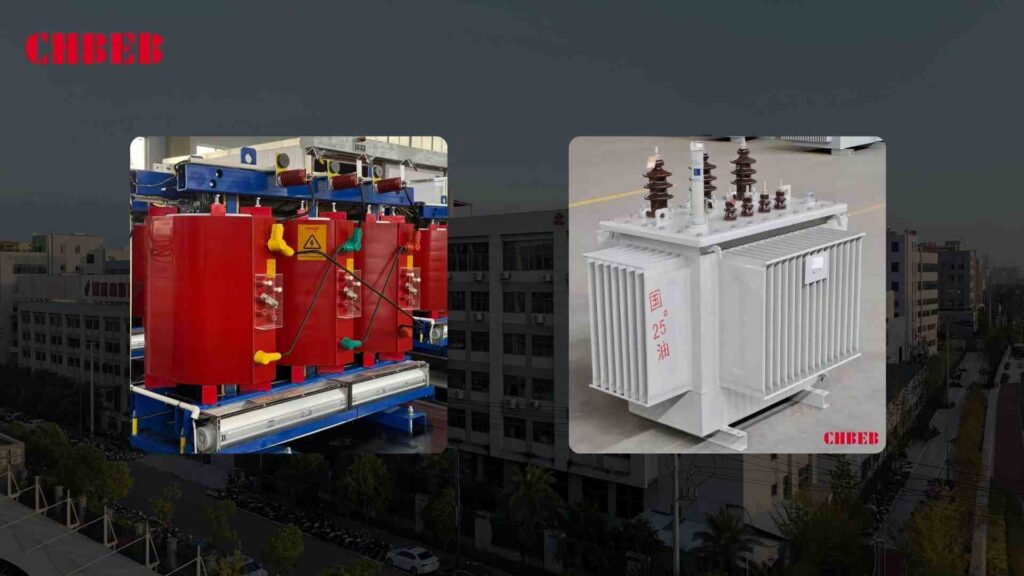
Only looking at the price per unit raises the total cost over time. Look at how well the technology fits, the risk of delivery, and the service model.
| Dimension | Chinese Leaders (China XD, TBEA, BTW, JSHP) | International Leaders (Siemens Energy, Hitachi Energy, GE Vernova, etc.) |
|---|---|---|
| Voltage/Scale | Extensive HV/EHV, up to 1100 kV; UHV/HVDC pedigree via State Grid projects. 西电集团 | Broad global portfolio; strong at premium ratings and complex specs. siemens-energy.com |
| Tech Focus | Compliance-driven, robust designs; accelerating low-loss materials and digital add-ons. | Advanced monitoring, eco-fluids, dry-type innovation, HVDC expertise. hitachienergy.com |
| Delivery & Scale | Large local capacity, competitive lead times for grid-standard builds. | Longer scheduling for imported or high-customization units. |
| Pricing | Generally lower CAPEX; strong value for standardized specs. | Higher CAPEX; potential OPEX savings via losses/uptime. |
| References | UHV corridors, national tenders, massive domestic base. news.metal.com | Global flagship projects; strong multinational service networks. siemens-energy.com |
| Best Fit | State-backed infra, standard renewables, utility distribution. | High-spec renewables, industrials with strict LCC targets. |
Buyer’s Guide: How to Choose the Right Brand for Your Project
Redesigns that cost a lot of money happen when the scope and tender documentation aren’t clear. Not doing certification or service checks could cause downtime. Solution: a five-step selection process that takes losses into account.
- What is a scenario and risk tolerance (PAS ≤50 words): Incorrectly scoped voltage, cooling, or environment might add hidden costs over time. Tighten the use case: transmission, substation, plant GSU, or industrial distribution? Make sure you understand the ambient, harmonic profile, noise restrictions, footprint, and grid-code compliance.
- Lock down technical baselines
- Voltage/kVA and duty: GSU vs step-down; overload and backup profile.
- Loss classes: Set GB/IEC targets (like S20) that guarantee no-load/load loss and include penalty clauses.
- Fire safety and site restrictions; ONAN/ONAF/ODAF vs. dry-type; cooling and insulation.
- Standards and tests: IEC/GB, routine/type/special (for example, temperature rise, impulse, and sound).
- Map needs to brands
- Chinese officials want uniform grid builds, more exposure to UHV/HVDC, and speedier local delivery.
- When digitization, eco-fluids, or very low total losses drive payback, international leaders. siemens-energy.com
- Check the market momentum for 2025 (PAS ≤50 words): Old pipeline data messes up schedules. Check the capacity and tender activities, such State Grid’s record spending in 2025 and current UHV procurements, to figure out how much work suppliers have and how long it will take. Reuters
- Do a comparison of lifetime costs (LCC)
- Model the cost of energy for the next 25 to 30 years, together with the site’s tariff forecast.
- Include upkeep, spare parts, digital monitoring, and the chance of an outage.
- Look at the trade-offs between capital expenditures (capex) and kilowatt-hour (kW) loss. A more expensive unit can win on operating expenses (OPEX) in 3–7 years, which is what most industrial tariffs assume.
Checklist for due diligence
- References: Installations with similar duties from 2020 to 2025.
- Factory audits: winding, cutting the core, vacuum drying, and FAT capabilities.
- ISO 9001/14001, IEC type test reports, and GB conformity are all examples of certificates.
- Contracts: Loss assurances with penalties and local service available.
Conclusion
China’s transformer market in 2025 combines scale, speed, and innovation. The choice is no longer just between domestic and international names, but between cost-efficient capacity and premium technology with long-term payback.
Domestic leaders (China XD, TBEA, Baoding Tianwei, JSHP) remain the first choice for UHV/HVDC corridor projects, rapid delivery, and standardized grid builds. They bring proven State Grid references, cost competitiveness, and strong local scale.
International giants (Siemens Energy, Hitachi Energy, GE Vernova, Schneider, Mitsubishi) deliver eco-fluids, digital monitoring, and premium loss profiles, making them ideal for complex renewable integration, multi-country operations, and projects with strict lifecycle cost (LCC) targets.
👉 How to decide:
Map your scenario and risk tolerance: transmission, substation, GSU, or industrial distribution.
Lock down technical baselines: voltage/kVA, loss class, cooling method, and compliance standards.
Compare lifecycle costs (CAPEX + OPEX + downtime risk), not just upfront price.
Verify suppliers with recent references, certificates, and service coverage.
✅ Final takeaway: The best brand is not the biggest logo, but the one that aligns with your technical duty, delivery certainty, and 25-year cost model. In 2025, winners will be those who balance grid-scale capacity with digital reliability.
Learn More
Looking for the right dry-type transformer for your project? Download our latest product catalog or browse our product categories to find reliable solutions tailored to your needs.
Introduction
If you pick the wrong transformer, you could have to pay a lot of money for downtime, safety issues, and maintenance problems. A lot of buyers have trouble figuring out which type is best for their project. This guide explains the distinctions between dry type and oil-immersed transformers1 so you can make a confident choice.
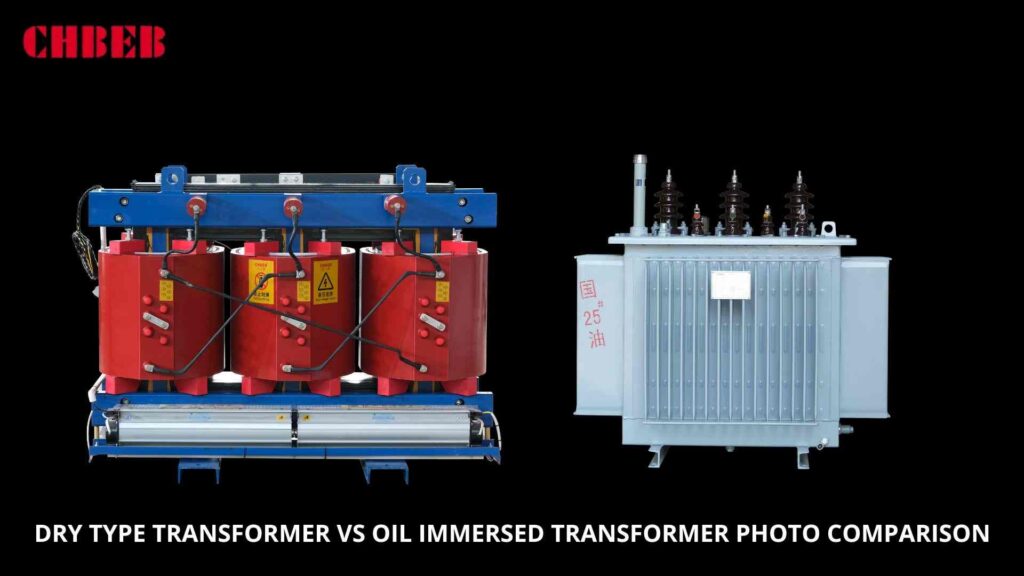
The Main Difference: How They Function
Transformers may seem the same, but the way they deal with heat and insulation is what sets them apart. If you don’t grasp this, things can go wrong, accidents can happen, or things can break down too soon. Let’s go into the main rules for how it works.
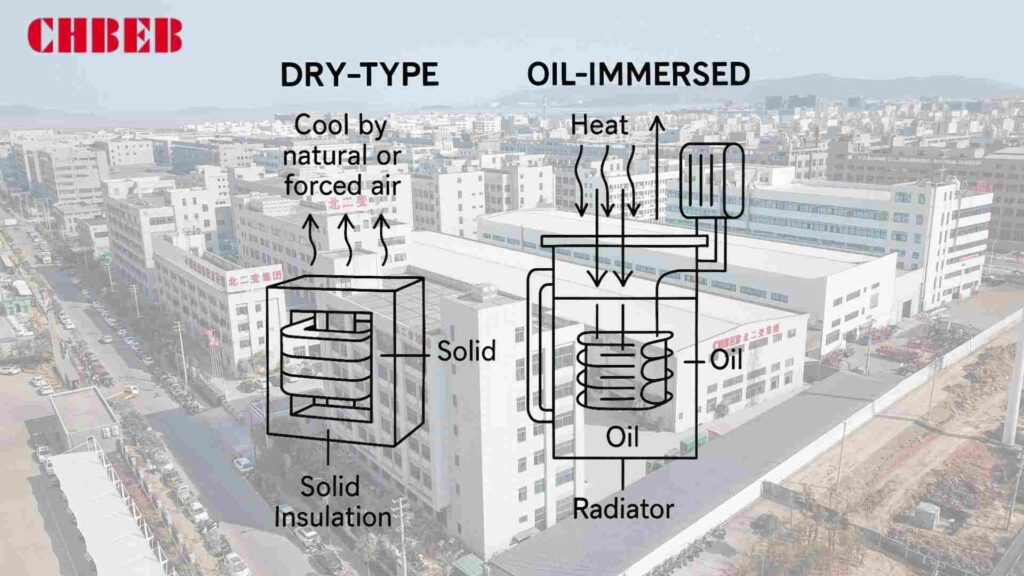
Dry-Type Transformers: Depend on Solid and Air
Instead of liquid, dry-type transformers use air and solid insulation materials.
- Cooling: either by natural means or by forced air.
- Epoxy resin, pressboard, or composite materials are used for insulation.
- Main Benefits: Less chance of fire, less harm to the environment, and can be used indoors.
- Normal Uses: schools, hospitals, commercial buildings, and interior substations.
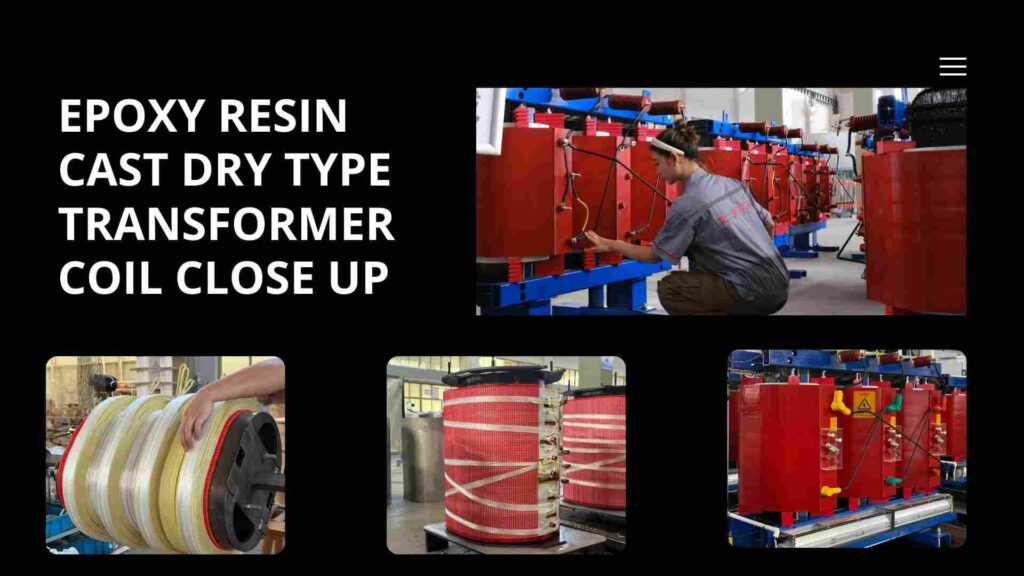
The Role of Dielectric Fluid in Oil-Immersed Transformers
Mineral or synthetic oil is used to insulate and cool oil-immersed transformers.
- Cooling: Oil takes in heat and moves it to radiators or coolers.
- Insulation: Oil makes dielectric strength stronger and stops electrical arcs.
- Key Benefits: Can handle heavier loads and lasts longer when used heavily.
- Common Uses: Substations in the open air, industrial plants, and utility-scale distribution.
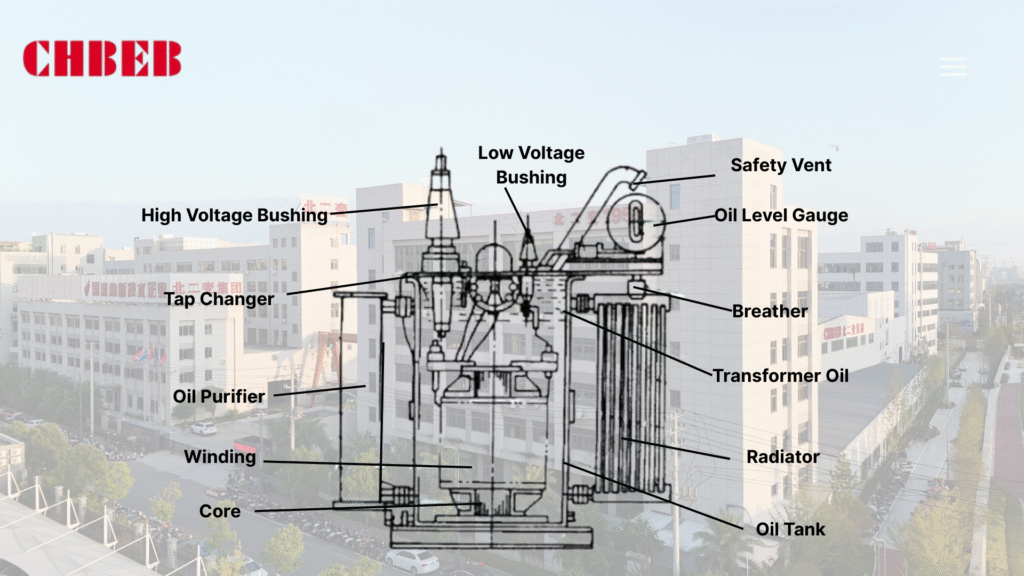
The 5 Key Differences: A Side-by-Side Comparison
Picking the improper type can have an impact on safety, cost, and performance. Here is a full comparison of the five most important things.
1. Safety and Effects on the Environment
Accidents with electricity or oil leaks might be quite bad.
| Feature | Dry-Type | Oil-Immersed |
|---|---|---|
| Fire Risk | Low (no flammable liquid) | Higher (oil is flammable) |
| Environmental Impact | Minimal, non-toxic | Oil spills can contaminate soil/water |
| Indoor Suitability | Ideal | Requires special precautions |
Dry-type transformers work well in small or sensitive spaces, while oil-immersed units need to be kept safe from fire and other hazards.
2. Cost: Initial Investment vs. Total Cost of Ownership (TCO)2
The price you pay to buy it is only part of the story.
- Dry-Type: Higher initial cost per kVA, but reduced insurance and maintenance costs.
- Oil-Immersed: Costs less up front, but costs more to maintain, test oil, and clean up spills.
Tip: Don’t simply look at the sticker price; think about the total cost of ownership (TCO), which includes things like energy losses, maintenance, and longevity.
3. Upkeep and Longevity
The complexity of maintenance can have an impact on downtime and costs of doing business.
| Feature | Dry-Type | Oil-Immersed |
|---|---|---|
| Routine Maintenance | Minimal (dust removal, visual checks) | Frequent (oil testing, leak checks, cooling system inspection) |
| Lifespan | 20–30 years | 25–40 years with proper care |
| Downtime Risk | Lower | Higher if leaks or faults occur |
If you don’t want to have to do much work on them, dry-type transformers are a good choice. Transformers that are immersed in oil need extra care, but they work well even when there is a lot of weight on them.
4.Load Capacity and Efficiency
Efficiency affects how much it costs to run and how much energy is wasted.
- Dry-Type: Usually has a lower load capacity and may lose a little more power when fully loaded.
- Oil-Immersed: Handles more weight and cools better; works better for big or industrial uses.
Tip: Pick based on what you need to carry. Oil-immersed versions are frequently better for big industrial applications.
5.Putting it together and using it
The installation environment decides what is practical.
| Feature | Dry-Type | Oil-Immersed |
|---|---|---|
| Indoor Use | Excellent | Needs safety measures and containment |
| Outdoor Use | Limited, requires enclosures | Ideal for outdoor substations |
| Space Requirements | Compact | Larger footprint due to cooling equipment |
| Noise | Quiet | Moderate, may need sound reduction |
Transformers that are dry-type work well indoors with little chance of fire, whereas oil-immersed transformers are best for heavy-duty outside use.
Making the Right Choice: A Summary Guide
Choosing the correct transformer will keep you safe, make sure it works, and save you money.
When to Choose Dry-Type:
- Installation within schools, hospitals, or businesses
- Having a low risk of fire is very important.
- It is best if there is little maintenance.
- Environmental sensitivity is a worry
When to Choose Oil-Immersed:
- For use outside or in factories
- You require a lot of load capacity.
- Long longevity under heavy use is needed
- There is extra money in the budget for safety and upkeep.
Conclusion
Dry-type and oil-immersed transformers each have unique strengths, and the right choice depends on your project’s safety requirements, budget, and operating environment.
- Choose a Dry-Type Transformer if your installation is indoors, in sensitive locations such as hospitals, schools, or commercial buildings, where fire safety, low maintenance, and environmental protection are top priorities.
- Choose an Oil-Immersed Transformer if your application demands high load capacity, long service life under heavy operation, and outdoor suitability, such as in substations, industrial facilities, or utility-scale distribution networks.
When evaluating, don’t stop at the purchase price. Consider the Total Cost of Ownership (TCO), including energy efficiency, downtime risks, and ongoing maintenance. A well-matched transformer not only ensures safe and reliable operation, but also maximizes your ROI by reducing long-term costs and improving system performance.
👉 Final tip: Align your transformer choice with your installation environment, load requirements, and risk tolerance. This structured approach will help you avoid costly mistakes and secure a solution that is both efficient and sustainable.
- Oil-Immersed Transformer: Construction, Working and Applications ↩︎
- Transformer Total Cost of Ownership ↩︎
Learn More
Looking for the right dry-type transformer for your project? Download our latest product catalog or browse our product categories to find reliable solutions tailored to your needs.
Introduction
You shouldn’t have to guess how much a transformer will cost. Prices are hard to pin down because materials, requirements, and lead times change. This guide makes the prices of 2025 dry-type transformers obvious by turning them into tables and steps. This will help you plan correctly and buy with confidence.
2025 Dry-Type Transformer Price Guide: Cost by kVA Ratings
When you skip capacity, voltage, or safety adders, you get sticker shock. To avoid underbids and change orders, you should know the price ranges and what is included.
What is the price of a dry-type transformer per kVA?
Assumptions: three-phase, 50/60 Hz, standard indoor installation, normal impedance, IEC/IEEE compliance, ex-works (no freight, tax, or extras). VPI is about the same as the baseline, but cast resin costs more.
| Rating | Typical HV/LV (kV) | VPI Price Range (USD) | Cast-Resin1 Price Range (USD) | Approx. $/kVA (VPI) | Typical Use Cases |
|---|---|---|---|---|---|
| 100 kVA | 6–11 / 0.4 | $6,000–$10,000 | $8,000–$12,500 | $60–$100 | Shops, small offices, light commercial |
| 500 kVA | 6–15 / 0.4–0.69 | $12,000–$22,000 | $16,000–$28,000 | $24–$44 | Campuses, retail hubs, small factories |
| 2000 kVA | 11–24 / 0.4–0.69 | $38,000–$80,000 | $50,000–$100,000 | $19–$40 | Hospitals, metro stations, larger plants |
- Cast-resin premium: usually 15–30% more than VPI at the same rating.
- For a higher voltage class (22–35 kV), add 8–20% for BIL, insulation, and clearances.
- Low-loss cores (amorphous/Hi-B): add 10–15% up front and cut no-load losses.
The VPI standard spec says that for every kVA: 100 kVA: $60–$100/kVA; 500 kVA: $24–$44/kVA; 2000 kVA: $19–$40/kVA. Higher ratings lower the price per kVA.
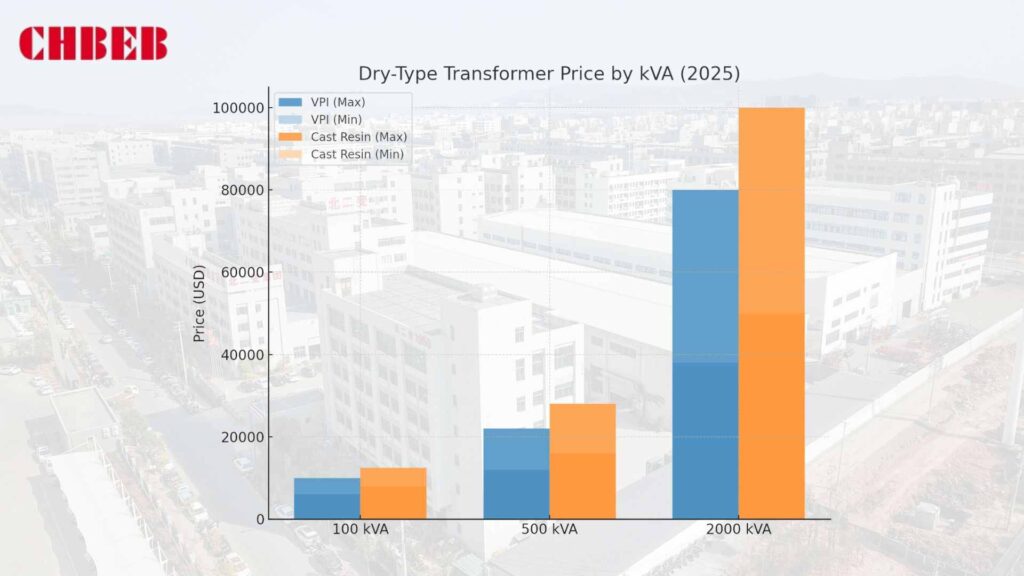
What Will Cause the Prices of Dry-Type Transformers to Change in 2025?
Small design choices add up rapidly. Add prices early to stop the budget from going up.
- Copper is more expensive and has fewer losses, while aluminum is less expensive and has a bigger cross-section.
- Core steel: High-grade grain-oriented or amorphous cores cut down on losses when there is no load, but they also raise the cost per unit.
- Class F/H, low-smoke/halogen-free resins, and humidity protection add to the cost of the insulation system.
- Fans (AF), RTDs, relays, thermal scanners, and Modbus/IEC 61850 gateways add 3 to 15% for cooling and monitoring.
- Acoustics and enclosure: Filters and coatings that make designs quieter and raise IP/NEMA ratings by 5–20%.
- Compliance and testing: IEC/IEEE routine and type tests, UL/CE markings, witness FAT, and paperwork all take time and money.
- Freight, customs, and foreign exchange rates can change the price of goods by 5% to 25%.
- Lead time: Quotes can go up a lot because to rush premiums and backlog cycles.
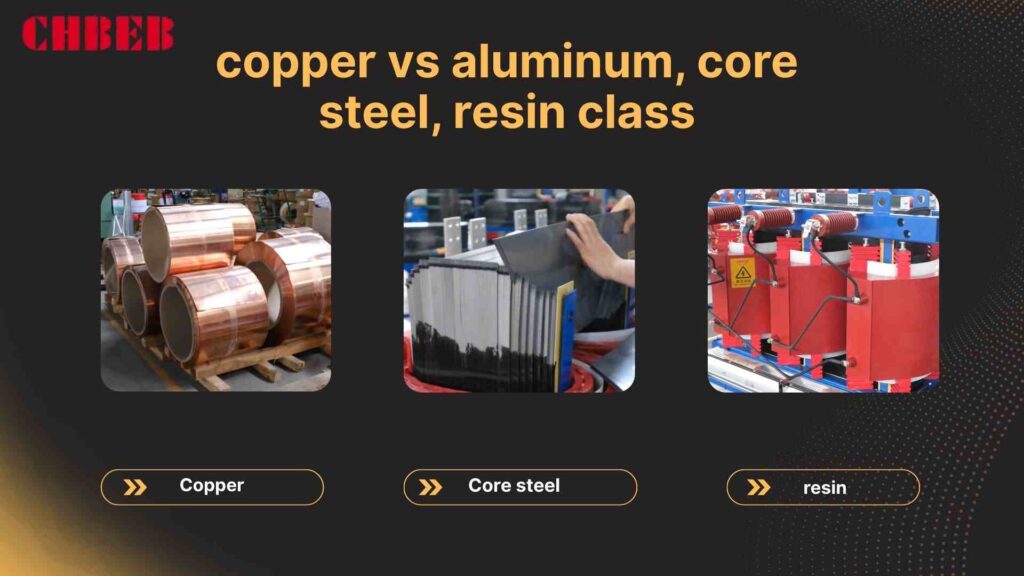
Total Cost of Ownership (TCO)2: More than the Price Tag
It can cost more later to buy an inexpensive unit. Energy losses and downtime are sometimes much bigger than tiny capex reductions. Don’t simply look at the quote; look at the lifetime cost.
Why efficiency is important for the long-term costs of transformers
Every hour, there are losses. No-load runs all the time, and load losses go up with current and harmonics. Saving a few kilowatts can save you a lot of money over your lifetime.
A simplistic example:
- Option A: 2000 kVA, Aluminum VPI: Buy for $60,000; lose about 12 kW.
- Option B: 2000 kVA, Copper Cast-Resin: Buy for $85,000; losses are about 9 kW.
Let’s say $0.12 per kilowatt-hour, 8,760 hours per year, and 20 years.
A: 12 × 8,760 × $0.12 = $12,614 every year, which is $252,000 over 20 years.
B: 9 × 8,760 × $0.12 = around $9,460 a year, or $189,000 over 20 years.
Energy delta: B saved almost $63,000, which helped make up for the increased capital expenditures, not including the thermal margin, uptime, and resale value.
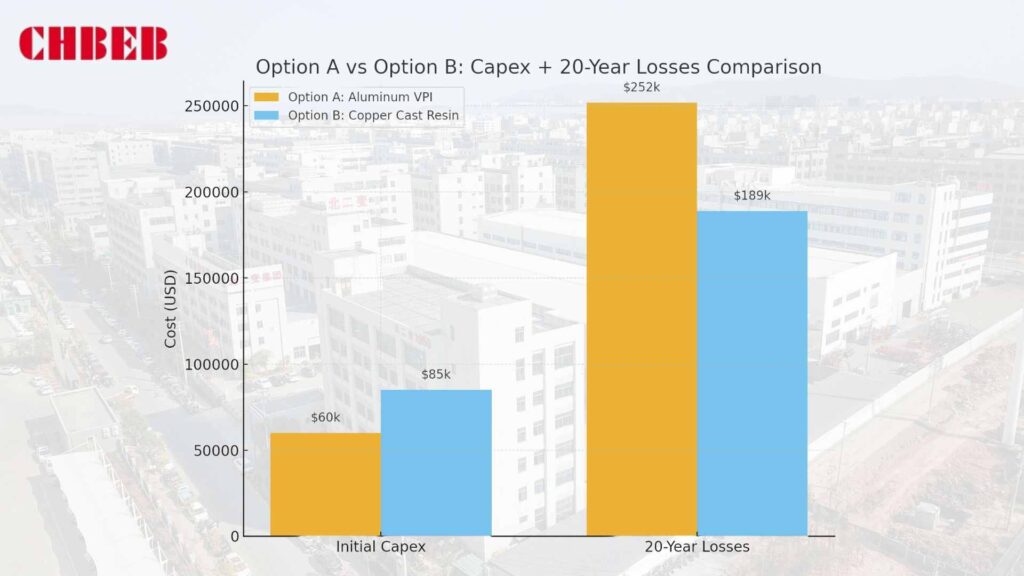
- Make loss assurances in the PO stricter (with penalties for going over).
- Think about harmonics (drives/EV). It may be necessary to use a K-factor or derating.
- Check the ambient temperature, altitude, and duty cycle; these all affect the rise in temperature and the life of the device.
How to Get a Formal Quote for a Transformer in 2025
When specifications are unclear, quotes change. Give a clear brief to generate numbers that are similar and can be defended.
- kVA and duty: continuous rating, overloads, and temperature/altitude.
- Voltage and taps: LV/HV, vector group, tap range/steps (off-load/OLTC).
- Technology: VPI or cast resin; conductor made of copper or aluminum.
- Loss targets: no-load/load losses are assured, and there is a punishment schedule.
- Class (e.g., 80K/100K), natural/forced air, and fan phases for temperature rising and cooling.
- Enclosure and IP/NEMA: for indoor and outdoor use, with filters and coatings for coastal and corrosive environments.
- Sound: maximum dB(A) at a certain distance; site limitations.
- Compliance: IEC/IEEE editions, UL/CE, routine/type tests, and witness FAT.
- Monitoring: RTDs, relays, and communications (Modbus, IEC 61850, and BACnet).
- Logistics: making crates, finding lifting points, setting footprint limitations, and delivery windows.
- Commercials: warranty, service SLAs, spare parts, training, and references.
Tip: Ask vendors to provide you a price for a baseline and a low-loss option next to each other. Then compare the cost of capital plus 10/20 years of energy.
Conclusion
The cost of a dry-type transformer in 2025 depends mainly on its kVA rating, voltage level, and design choices (e.g., insulation system, core materials, technology). Using benchmarks such as 100 / 500 / 2000 kVA helps set realistic budgets, while accounting for adders like higher voltage class, low-loss cores, and enclosure/IP requirements prevents surprises later.
Looking beyond the sticker price is essential. By evaluating the Total Cost of Ownership (TCO)—including energy losses, maintenance, and downtime—buyers can identify options that save more over the service life of the unit.
A clear and accurate RFQ, backed by firm loss guarantees and compliance checks (IEC/IEEE, UL/CE where applicable), remains the best way to secure a transformer that is reliable, efficient, and cost-effective for decades of operation.
Learn More
Want to explore more transformer solutions? Download our latest product catalog or browse our product categories to find the right transformer for your project.
Introduction
It’s hard to figure out how to budget for dry-type transformers. Prices change based on the materials and demand, and suppliers give varying quotes. One mistake leads to spending too much and delays. This guide makes it easier to understand 2025 prices, drivers, and supplier strategy so you can make a choice with confidence.
Dry-Type Transformer Price Landscape in 2025: Key Drivers
When transformer costs go up more than expected, projects collapse. Quotes are affected by materials, technology, and following the rules. You can prevent hidden costs and make accurate budgets if you know price ranges and drivers.
How Much Does a Dry-Type Transformer Cost by kVA in 2025?
The price changes the most based on the voltage class and capacity (kVA). The ranges below are for typical three-phase systems that are shipped directly from the factory. Shipping, taxes, testing, and installation are not included.
| kVA Rating | HV Range | VPI Price (USD) | Cast-Resin1 Price (USD) | Typical Uses |
|---|---|---|---|---|
| 50–200 | 6–11 kV | $4,000–$12,000 | $6,000–$15,000 | Shops, small offices |
| 250–500 | 6–15 kV | $9,000–$22,000 | $12,000–$28,000 | Campuses, retail |
| 750–1,000 | 10–20 kV | $18,000–$40,000 | $24,000–$55,000 | Factories, mid-size plants |
| 1,250–2,000 | 11–24 kV | $32,000–$75,000 | $42,000–$95,000 | Hospitals, metro stations |
| 2,500–3,150 | 11–33 kV | $60,000–$125,000 | $80,000–$160,000 | Industrial feeders |
| 4,000–5,000 | 13.8–35 kV | $110,000–$220,000 | $145,000–$290,000 | Utilities, heavy industry |
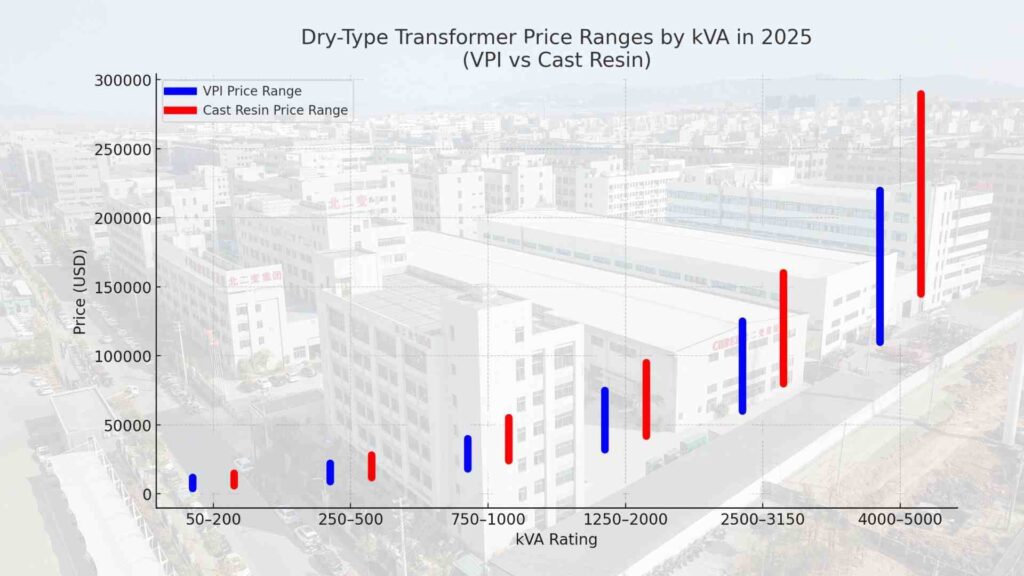
- Impact of technology: Cast-resin usually costs 15–30% more than VPI because of the fire safety and epoxy casting.
- Voltage effect: When you move up to 22–35 kV, the strength and clearances of the insulation normally get up by 8–20%.
- Regional differences: North America tends to be higher (UL/CSA), whereas Asia tends to be lower (localized supply chains).
What Will Affect the Prices of Dry-Type Transformers in 2025?

Small design changes might quickly change the pricing. Knowing these things stops budget shocks from happening.
- Copper is a better conductor than aluminum because it makes things work better and can handle short circuits better (around 20–40% more expensive).
- Quality of core steel: Grain-oriented or amorphous cores cut no-load losses by 10–15% of capital expenses.
- Insulation and resin: Higher-class (like Class H) and low-smoke resins make things safer and more expensive.
- Accessories like RTDs, temp relays, forced-air blowers, heaters, and sound kits add about 5–25%.
- Compliance testing: IEC/IEEE type tests, UL/CE, and FAT documents take more time and money.
- Freight and tariffs: Ocean freight, import fees, cranes, and permissions can change the price by 10% to 25%.
- Lead time and FX: Quotes are affected by rush orders and currency changes. Longer lead times usually get better prices.
For example, a 1,000 kVA cast-resin unit in Europe may cost $45,000 ex-works, but shipping, customs, and FAT testing can make the total cost more than $60,000.
Total Cost of Ownership (TCO) and a Guide for Suppliers
A low price up front can be a trap. Over the course of 20 years, losses, downtime, and insufficient support cost more. Calculating TCO and checking out suppliers helps keep lifetime value.
What is the real total cost of ownership (TCO) for dry-type transformers?
TCO = Purchase Price + Installation + Energy Losses + Maintenance + Downtime − Residual Value
- Energy losses: No-load runs all the time; load losses go up with current and harmonics.
- Lower than oil-filled, however fans, RTDs, and windings need to be checked on a regular basis.
- Risk of downtime: One outage in a hospital or metro can cost more than the purchase price.
- Residual value: Premium items that are fully certified keep their resale value.
For example, Option A (Aluminum VPI) costs $120,000 and loses around 12 kW, while Option B (Copper Cast-Resin) costs $150,000 and loses about 9 kW. Option B saves over $140,000 in energy over 20 years at $0.12 per kilowatt-hour, which more than makes up for the $30,000 disparity in capital expenditures..
Don’t buy based on sticker price; lifetime cost is more important than losses.
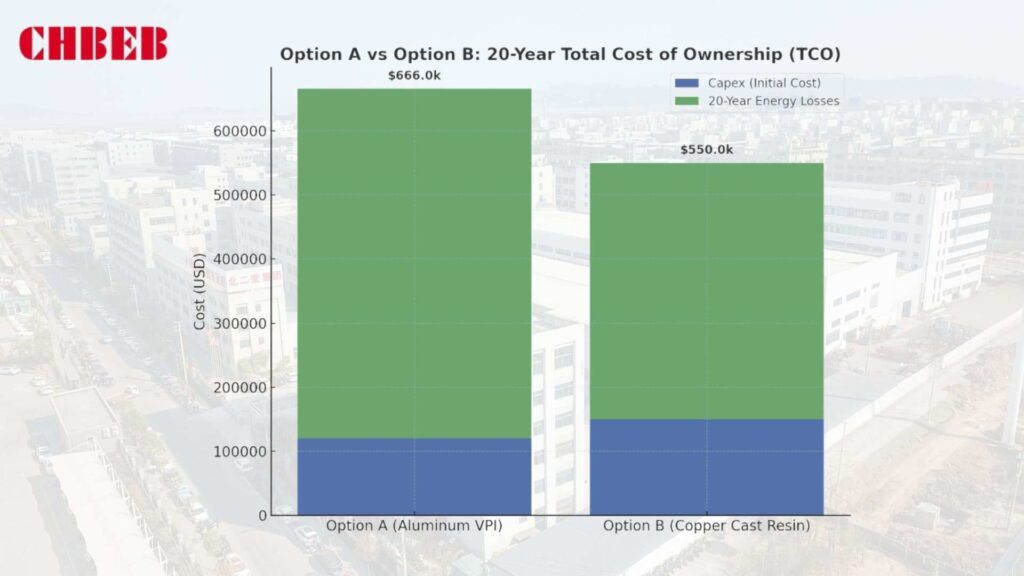
How to Pick the Best Dry-Type Transformer Supplier in 2025
A bad supplier can cause delays, extra expenditures, and problems with compliance. Match your strengths to your risk profile and your timetable.
- Global giants like Hitachi Energy, Siemens, and Schneider have proven technology, good documentation, and spare parts available all over the world. However, they cost more and take longer to get.
- Regional champions (Eaton, Toshiba, TBEA): faster delivery, knowledge of local codes, and prices that are comparable. Check the depth of QA.
- OEM/ODM experts (Daelim, niche makers): make custom builds for small spaces, low noise, and tough sites; check factories and ask for type-test results with FAT witness choices.
Checklist for suppliers:
- IEC/IEEE compliance with routine and type test reports; UL/CE as needed
- Guaranteed no-load and load losses with penalty clauses
- Temperature rising class, cooling stages, and control of hot spots
- Noise level guaranteed at a certain distance (in cities)
- Terms of warranty, service SLAs, replacement parts and training in your area
- Look at projects with the same kVA/voltage and surroundings.
Warning signs: confusing drawings, missing test data, “equivalent” exchanges after the purchase order, ambiguous warranties, and pressure for big prepayments.
Put loss assurances in the contract as a practical recommendation. Small discrepancies in no-load can add up to tens of thousands over the term of the contract.
Conclusion
In 2025, the cost of a dry-type transformer is driven mainly by kVA rating, voltage level, materials/technology (e.g., copper vs2. aluminum; VPI vs. cast-resin), and compliance requirements (IEC/IEEE, UL/CE). Looking only at the sticker price can be misleading—lower upfront cost may mean higher energy losses, more downtime, and unexpected maintenance over the life of the unit.
For engineers & technical buyers
Evaluate the Total Cost of Ownership (TCO): Purchase + Installation + Energy Losses + Maintenance + Downtime − Residual Value. Higher-efficiency designs (e.g., copper windings or cast-resin insulation) can reduce losses and often save six-figure amounts on energy over a 20-year horizon.
For project owners & procurement managers
- Don’t compare on price alone—request type/routine test reports and ensure IEC/IEEE compliance.
- Ask for guaranteed losses with penalty clauses and clear warranty/service terms.
- Consider lead time, documentation quality, and after-sales support as part of value.
By looking beyond initial quotes and focusing on long-term performance, you’ll secure a transformer that is safe, efficient, and cost-effective. Partnering directly with a source factory like CHBEB can combine competitive pricing with faster delivery and international-standard quality, giving you confidence from specification to commissioning.
- Cast Resin Transformers — All About Circuits ↩︎
- Copper vs. Aluminum in Transformer Windings — ScienceDirect ↩︎
Learn More
Want to explore more transformer solutions? Download our latest product catalog or browse our product categories to find the right transformer for your project.
Introduction
Prices seem to change all the time, and one false guess might ruin your budget. Next come delays and gaps in compliance. This tutorial talks about the costs of dry-type transformers in 2025, what causes them, and how to pick vendors that will give you long-term value.
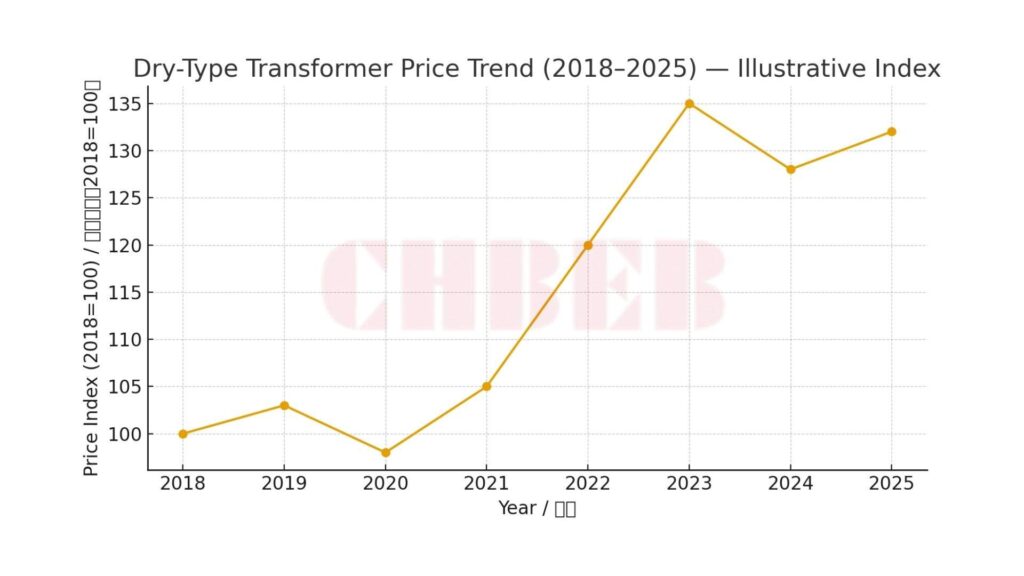
Price Trends and Main Factors Affecting Dry-Type Transformers in 2025
Sticker prices change according on metals, shipping, and requirements. If you don’t pay attention to this, bids will miss the mark. Know how kVA, voltage, materials, and tariffs impact quotations so budgets meet market conditions.
What is the price of a dry-type transformer based on kVA and voltage?
Wide price ranges (in USD) for typical three-phase VPI or cast-resin systems. Shipping, taxes, extras, testing, and installation are not included.
| kVA Class (3-phase) | Typical LV/HV (kV) | VPI Price Range | Cast-Resin Price Range | Notes |
|---|---|---|---|---|
| 50–200 kVA | 0.4 / 6–11 | $4,000–$12,000 | $6,000–$15,000 | Small commercial; indoor |
| 250–500 kVA | 0.4 / 6–15 | $9,000–$22,000 | $12,000–$28,000 | Campuses, retail, light industry |
| 750–1,000 kVA | 0.4–0.69 / 10–20 | $18,000–$40,000 | $24,000–$55,000 | Data room adjacency, small plants |
| 1,250–2,000 kVA | 0.4–0.69 / 11–24 | $32,000–$75,000 | $42,000–$95,000 | Hospitals, metro, factories |
| 2,500–3,150 kVA | 0.69 / 11–33 | $60,000–$125,000 | $80,000–$160,000 | Large commercial/industrial |
| 4,000–5,000 kVA | 0.69 / 13.8–35 | $110,000–$220,000 | $145,000–$290,000 | Utility tie-ins, heavy industry |
- When the voltage changes from about 11–15 kV to about 22–35 kV, the BIL, insulation, and clearances frequently go up by 8–20%.
- Effect of technology: Cast-resin usually costs 15–30% more than VPI at the same grade.
What factors affect price, such as materials, tariffs, and market forces?

- Copper conductors cost more1 to make and lose less energy; aluminum conductors cost less to make and have a bigger cross-section.
- Core steel: High-grade GO/amorphous lowers no-load losses but costs more.
- Insulation/resin: Class F/H, low-smoke standards make it more expensive.
- IP/NEMA enclosures, RTDs, relays, heaters, and sound kits add 3% to 20% to the price.
- Compliance and testing: IEC/IEEE type tests, UL/CE, and witness FAT take more time and money.
- Tariffs and freight: Duties, ocean and air fees, cranes and licenses can change the cost of delivery by 5% to 25%.
- FX and lead time: Changes in currency and rush fees effect quotes.
How to Pick a Reliable Supplier and the Total Cost of Ownership
Buying based on the sticker price doesn’t work. A low quote can be far less than the cost of downtime, maintenance, and losses. To make sure you get reliable service and savings, use TCO and supplier checks.
What is the real TCO of a dry-type transformer2, not just the price?
TCO = Purchase + Logistics/Install + Energy Losses + Maintenance + Downtime − Residual Value
- Energy losses: No-load runs all the time; load losses go up with current and harmonics.
- Cleaning, checking the fans and relays, and doing IR scans are all part of maintenance. It’s not as low as oil-filled, but it’s not zero either.
- Unplanned outages or derating often cost the most time.
- Residual value: Quality units with all the paperwork keep their resale worth.
For example:
- Option A (Aluminum/VPI): $120,000; 8 kW with no load; 18 kW with load loss at 50% average load.
- Option B (Copper/Cast): $150,000; 6 kW with no load; 14 kW with 50% average load.
- Power costs $0.12 per kilowatt-hour and lasts for 20 years, or 8,760 hours a year.
A losses about 12.5 kW, which is about $27.3k per year or $546k over 20 years. B losses are about 9.5 kW, which is about $20,000 a year or $400,000 over 20 years. B saves around $146,000 on energy, which makes up for the $30,000 increase in capital expenditures.
Which suppliers will provide you the best deal in 2025?
There isn’t one “best” fit for everyone. Match the strengths of the provider to the application, the risk, and the timetable.
- Global leaders: Deep engineering, good documentation, and a network of spare parts; more capital spending and longer lead times.
- Regional champions: quick delivery, knowledge of local codes, and low prices; check QA and traceability.
- OEM/ODM experts: tight footprints, low noise, harsh-site builds; check factories, go over type-tests, and see FAT.
Checklist for doing due diligence on a supplier:
- IEC/IEEE compliance, routine/type test reports, and UL/CE as needed
- No-load/load losses are guaranteed, however there are penalties.
- Temperature rising class, fan phases, and hotspot control
- Noise level is guaranteed at a certain distance.
- Rating for enclosures, filters, and coatings for coastal and corrosive sites
- RTDs, relays, and Modbus/IEC 61850 gateways for monitoring
- Crating, preparations for lifts and rigs, access issues, and lead time
- Terms of the warranty, service SLAs, spare parts package, and training
- Similar kVA/voltage and surroundings are used as references.
Red flags: drawings that aren’t clear, no loss caps, “equivalent” exchanges after the PO, missing serial test data, and terms for prepayment that are too forceful.
Conclusion
The cost of a dry-type transformer in 2025 is influenced by multiple factors: kVA rating, voltage level, materials, and compliance requirements. Looking only at the purchase price risks overlooking hidden costs that appear later in the lifecycle.
To make the right choice, buyers should go beyond initial Capex and carefully evaluate the Total Cost of Ownership (TCO). This includes energy losses over decades of operation, maintenance needs, potential downtime, and eventual residual value.
A structured approach makes the difference: define your technical requirements clearly, request transparent loss guarantees, and ensure that all equipment complies with IEC/IEEE standards. This not only prevents delays and budget overruns but also secures long-term safety and efficiency.
In short, matching transformer specifications to project conditions—whether in commercial buildings, industrial facilities, or renewable energy projects— is the key to achieving reliable performance and cost control throughout the transformer’s service life.
- Copper vs. Aluminum in Transformer Windings — ScienceDirect ↩︎
- Transformer Total Cost of Ownership — IEEE Xplore ↩︎
Learn More
Want to explore more transformer solutions? Download our latest product catalog or browse our product categories to find the right transformer for your project.
Introduction
It’s not easy to pick a brand of transformer. There are too many names and too much language, and making the wrong pick might cost you more and put your safety at danger. This guide tells you about the trends, top brands, and easy shopping tips for 2025 so you can make a smart choice.
The 2025 Market Landscape: Key Drivers and Trends
A lot of initiatives fail when customers don’t notice changes in the market. Demand for dry-type goods is rising for safety, environmental aims, and digital monitoring. This is what is causing growth and how it will effect your project.
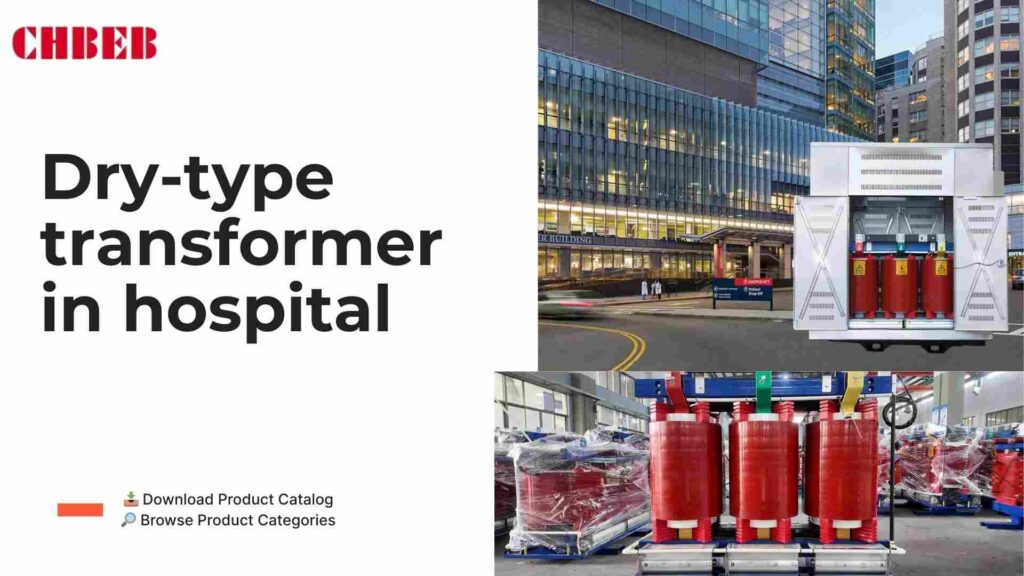
From renewable energy to smart cities, growth drivers
- Wind and solar power work best with dry-type devices that are safe from fire and oil.
- Smart cities: malls, hospitals, and subways need safer indoor transformers.
- More EV1 charging stations need reliable MV dry-type solutions.
- Regulation: Stricter restrictions about fires and the environment are making dry-type more popular.
For example, industry forecasts say that demand for dry-type goods could expand by about 6% each year until 2030.
Trends in technology: More and more digital and eco-friendly transformers
- Digital monitoring: Sensors keep an eye on health and temperature in real time.
- Eco-friendly materials: Resin systems and parts that can be recycled help the environment.
- Compact designs: Smaller, modular devices take up less area and are cheaper to install.
- Ready for renewable energy: Custom choices work nicely with inverters and storage.
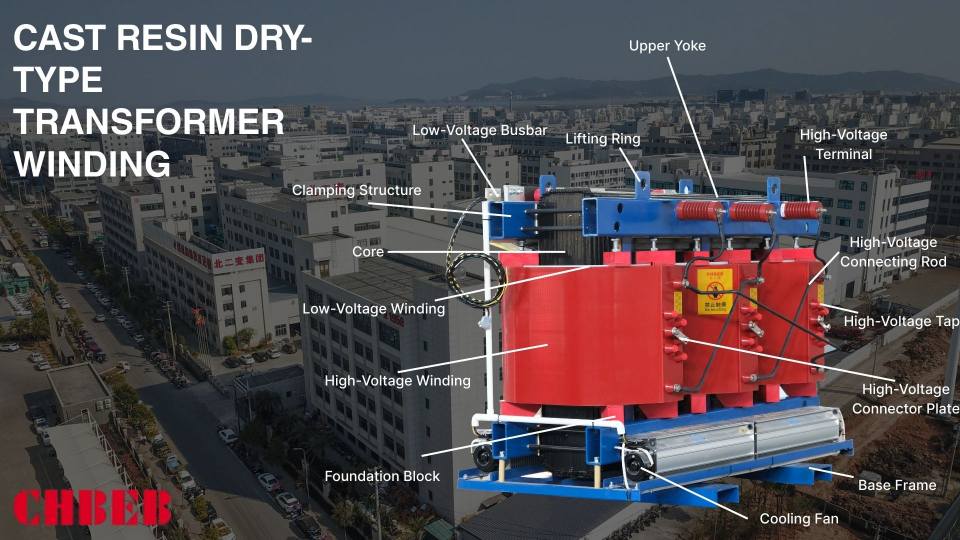
Profiles of the best dry-type transformer brands in the world
Different brands have different strengths. A bad match can cause delays or problems with compliance. Use this quick look at the leaders of 2025 to help you narrow down your list.
Hitachi Energy2 (ABB): The World Leader in Digital and Eco-Friendly Solutions
- Key strength: designs that focus on the environment and digital monitoring that is the best in its class.
- Why it matters: It’s a safe and reliable alternative for projects with a lot of demand.
- Where it is used: data centers, utility grids, and wind farms.
- Tip: Strong analytics make it a good choice for offshore wind.
Siemens Energy: The Powerhouse of the Industry and Infrastructure
- Key strength: High efficiency and little loss.
- Why it matters: It saves energy and is stable for lengthy duty cycles.
- Where it is used: hospitals, rail lines, and industrial complexes.
- Tip: This is very common in metro systems where uptime is very important.
The Digital and Energy Management Expert at Schneider Electric
- One of its best features is that it works well with EcoStruxure™ for predictive maintenance.
- Why it matters: It’s straightforward to use and keeps people safe inside.
- Smart buildings, colleges, and businesses all use it.
- Tip: This is common in hospitals and malls to follow fire codes.
Eaton and Other Important Players
- Eaton: VPI designs that are easy on the wallet and good service in North America.
- Toshiba: Works well in APAC and is suitable for projects with a lot of infrastructure.
- Daelim and TBEA are new competitors with low prices and a lot of exports.
- Local suppliers: They can supply faster and know a lot about local codes.
Strategic Analysis: A Buyer’s Guide for 2025
Just looking at brand names can be misleading. Look at the strengths and see how they fit your needs. The view below, which shows things side by side, makes judgments easy and useful.
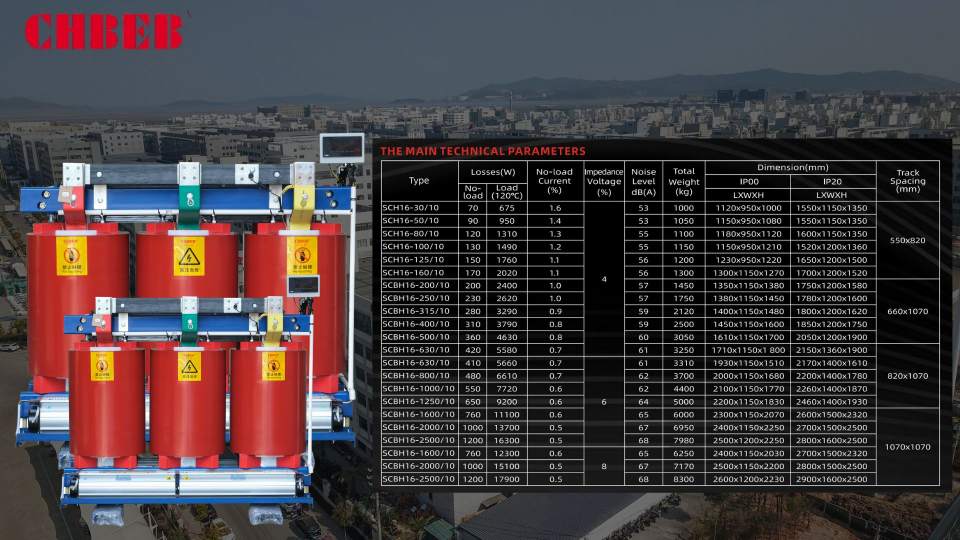
Key Differentiators: A Side-by-Side Comparison
| Brand | What They’re Best At | Best Applications | Global Reach | Buyer Concern Solved |
|---|---|---|---|---|
| Hitachi Energy | Digital monitoring, eco solutions | Utilities, renewables, data hubs | Global | Compliance, real-time visibility |
| Siemens Energy | Efficiency, infrastructure expertise | Transport, hospitals, industry | Global | Low losses, high uptime |
| Schneider Electric | Digital platform, fire safety | Buildings, campuses, malls | Global | Indoor safety, easy O&M |
| Eaton | Cost-effective VPI | Mid-size industry, NA market | North America | Budget control, quick service |
| Toshiba | APAC reliability | Infrastructure projects | Asia-Pacific | Long-term durability |
Choosing: How to Match Brands to Applications
- Utilities or renewables? Pick either Siemens or Hitachi Energy.
- Projects inside? Schneider is a better and safer alternative.
- Short on cash? Think about Eaton or strong local suppliers.
- Important places? For hospitals and metros, use cast resin from big brands.
A Look Ahead at the Market’s Future
- AI monitoring: Transformers that can find faults on their own.
- Greener buildings: using materials that can be recycled becomes normal.
- Local sourcing: Work with regional partners and global brands.
- Customization: More unique designs for storage and renewables.
Conclusion
In 2025, dry-type transformers will continue to evolve around safety, sustainability, and digital intelligence. Global leaders like Hitachi Energy, Siemens, and Schneider offer strong brand value, while cost-effective players such as Eaton, Toshiba, and Daelim meet regional demands.
However, beyond these names, source manufacturers like CHBEB Power provide unique advantages: faster delivery (7–15 days for standard units), flexible OEM/ODM customization, and proven compliance with IEC/ANSI standards. For many EPCs, utilities, and industrial clients, this balance of quality and agility delivers the best long-term value.
“The value of an idea lies in the using of it.” — Thomas Edison
Bottom line: Choosing the right transformer is not just about a name—it’s about matching real project needs with reliable technology, service, and cost control.
Learn More
Want to explore more transformer solutions? Download our latest product catalog or browse our product categories to find the right transformer for your project.
Introduction
Power transformers are very important for sending and receiving power, but how they are built on the inside is still a mystery. Not knowing parts can lead to bad design, slow performance, and problems with maintenance. This book goes into great detail about how transformers are built, focusing on how each item affects safety, dependability, and long-term performance.
Part 1: The Main Part of How the Transformer Works
The active parts of a transformer are what make it work. The transformer can’t safely operate or convert voltage stably if the core, windings, or insulation are badly built. Both purchasers and engineers need to know about these interior parts.
The Magnetic Core1: The Transformer’s Frame
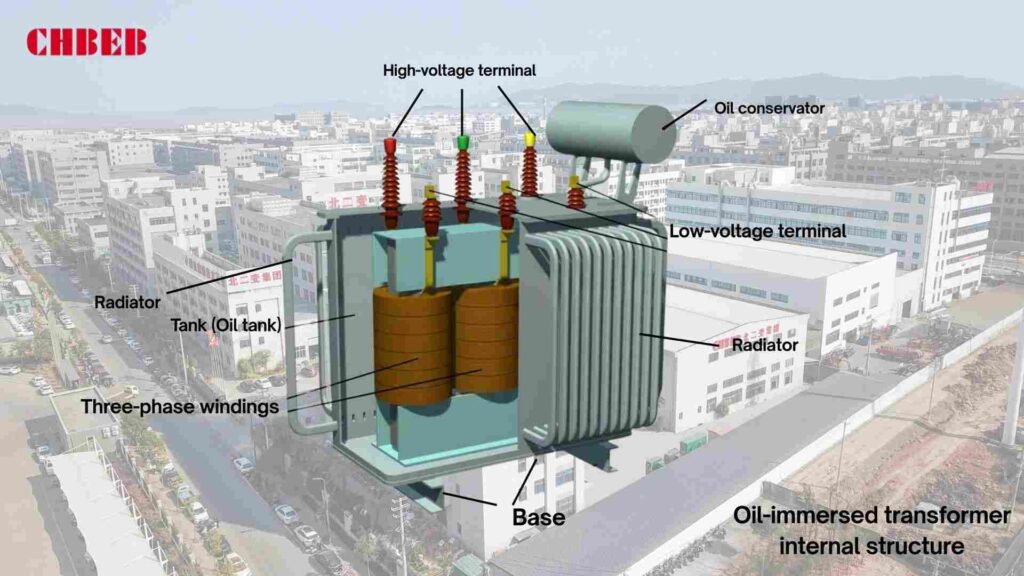
The magnetic core makes the skeleton of the transformer and gives the flux a path. It is usually built of laminated silicon steel sheets to cut down on losses from eddy currents. Amorphous alloy cores can be employed in designs that need to be very efficient. The shape of the core (core-type or shell-type) has a direct effect on the amount of loss, the strength of the structure, and the noise.
The Windings: The Transformer Core
Windings change the voltage of electrical energy. They are made of copper2 or aluminum conductors and are stacked in layers of high and low voltage. The low-voltage winding is usually closer to the core, and the high-voltage winding surrounds it. Buyers have to make a big choice between copper and aluminum since it impacts efficiency, short-circuit strength, and cost.
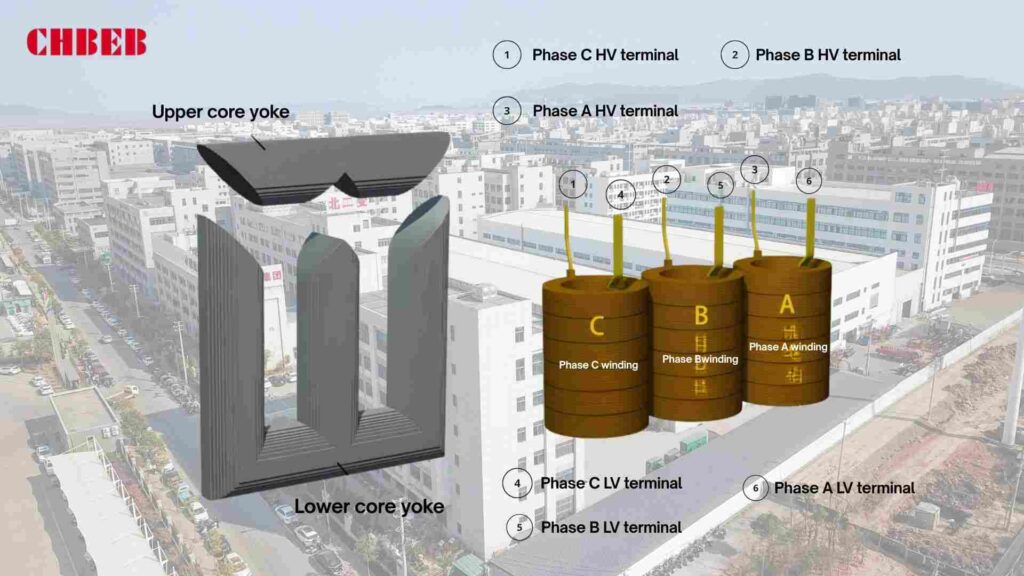
Insulation and cooling are the system’s lifeblood.
Insulation stops electrical problems from happening between the core and the windings. Pressboard, resin, and oil for liquid-filled transformers, or epoxy resin for dry-type designs are some of the materials used. Cooling systems get rid of the heat that builds up during use:
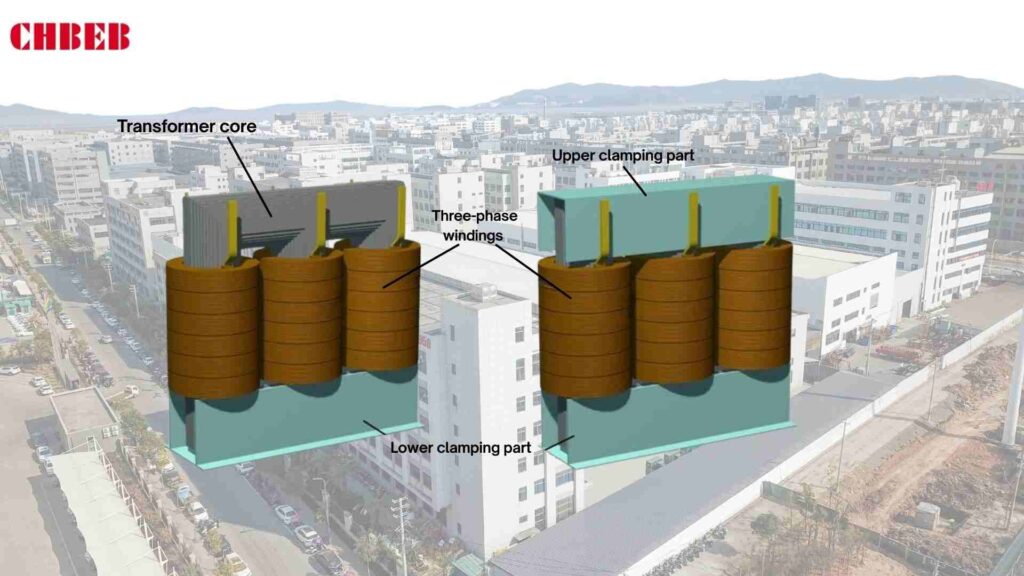
- Oil-immersed transformers: Mineral or ester oil provides both insulation and cooling. Heat dissipates through radiators or oil pumps with fans.
- Dry-type transformers3: Windings are encapsulated in epoxy resin, with natural or forced air cooling.
Both insulation and cooling affect how long something will last, how safe it is to use, and how well it can handle a load.
Part 2: The Transformer’s Systems for Support and Protection
Transformers need more than simply active parts to work. They also need external mechanisms to keep them secure and safeguard them. These parts protect against stress from the environment, electrical problems, and changes in voltage.
The Tank and Conservator: The Housing That Protects
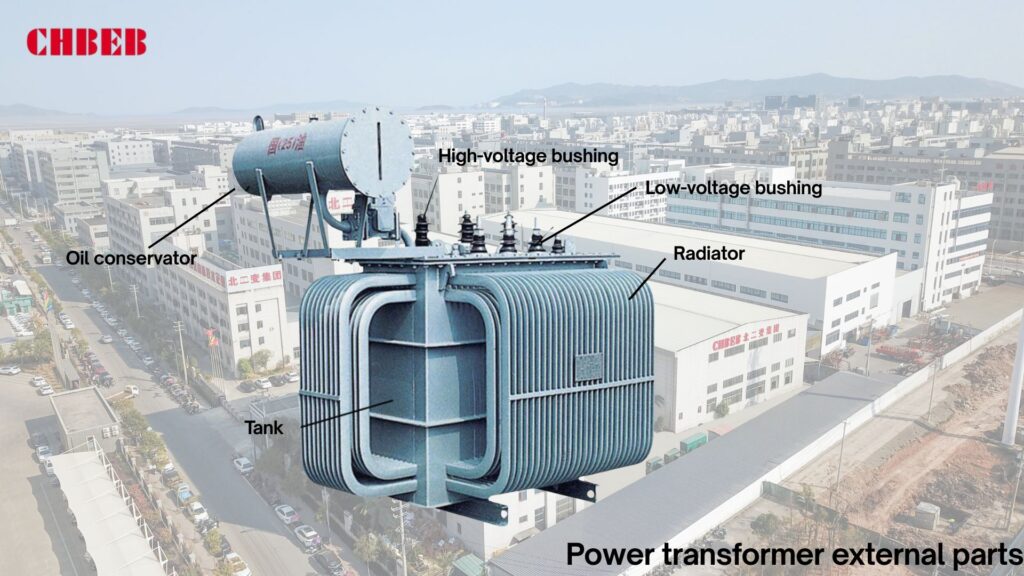
The oil tank, which is sometimes called the transformer tank, holds the active parts and is filled with insulating oil. There are radiator fins or cooling pipes around the tank that let heat escape. Forced circulation is done via external oil coolers and fans on bigger units.
The conservator, or oil reservoir, makes up for the oil expanding when the temperature changes. Sealed metal bellows or bladder-type conservators are typically used in modern designs to keep oil separate from air. This keeps moisture from getting into the oil and keeps it from oxidizing. For smaller facilities, sealed tanks with corrugated fins can be utilized instead of a conservator.
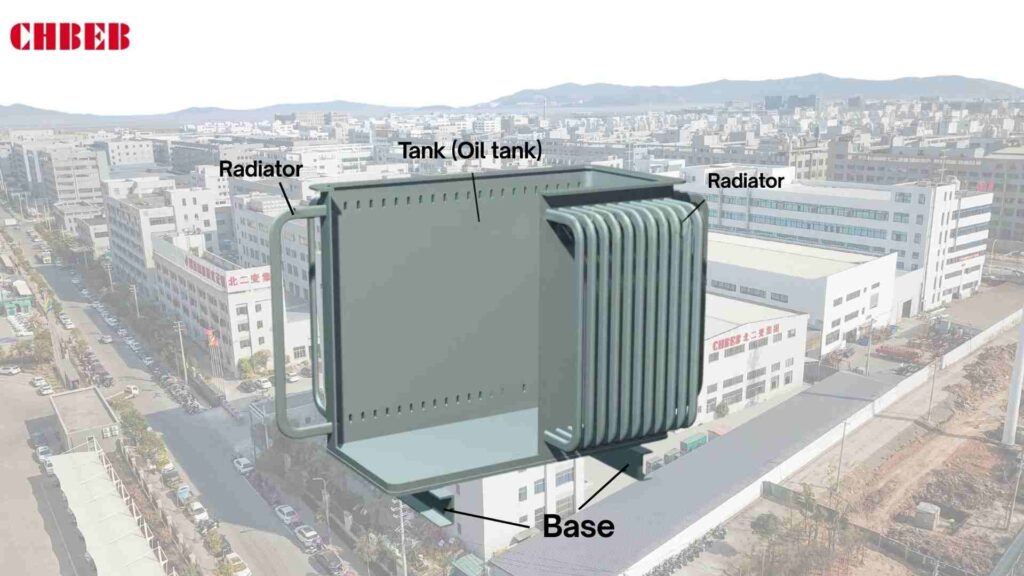
The Guardian Devices: The Buchholz Relay and Breather
For transformers that are filled with oil, protection is very important:
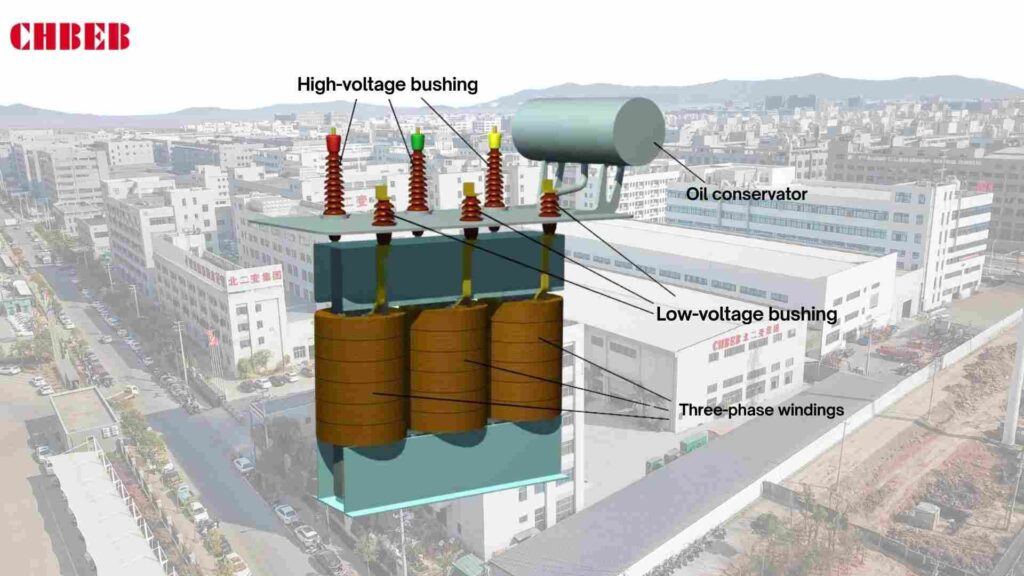
- Buchholz relay: This device is put between the main tank and the conservator. It detects gas buildup or abrupt oil movement and sends out early fault alerts and trip signals.
- Breather: Usually filled with silica gel, it filters and dries the air that comes into the conservator. This keeps the insulation oil from being too wet.
These devices work together to protect transformers, making them last longer and keeping them safe.
The Tap Changer is the voltage regulator.
Transformers need to change the output voltage because demand and the grid change. Tap changers vary the turns ratios in the winding to control voltage::
- Off-load tap changers: You have to replace them by hand when the transformer is not working.
- On-load tap changers (OLTC) automatically alter the voltage while the system is powered on, making sure that the supply never stops.
Tap changers are very important for keeping the grid stable and safe for sensitive equipment.
Part 3: Putting It All Together: Types of Construction and Common Problems
Even with good parts, a bad overall design might cause problems. Buyers may make smart choices about how to maintain and buy transformers by learning about the many types of transformers and the problems they often have.
A Look at Structural Design: Core-Type vs. Shell-Type
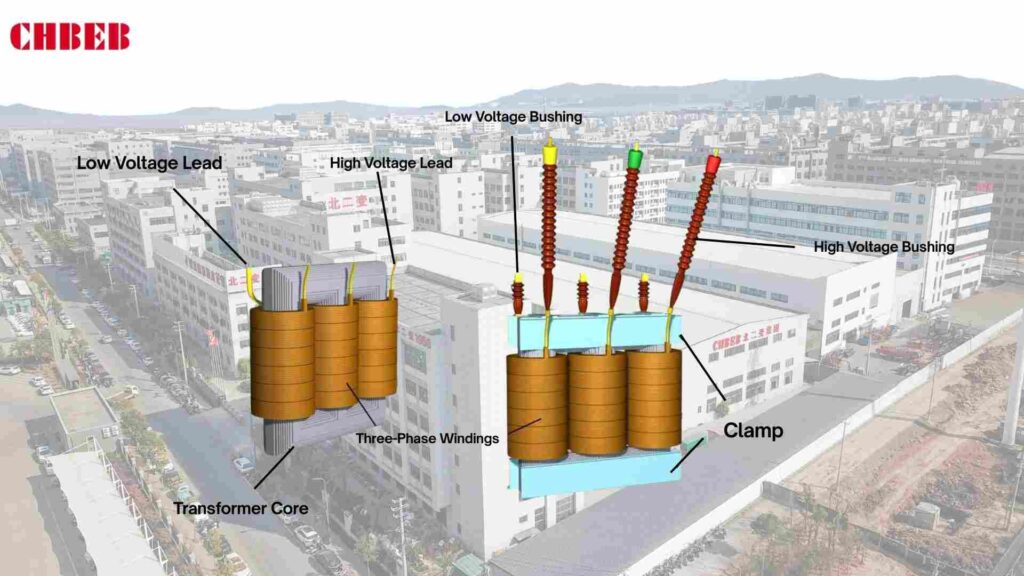
- Core-Type Transformers: The windings go around the core’s limbs. This design is common for high-voltage uses and makes it easier to cool down.
- Shell-Type Transformers: The core surrounds the windings, which makes them stronger and better able to handle faults. This kind is widely utilized in power plants and other big industrial settings.
The size of the application, the voltage level, and the cost are all factors that affect the choice between core and shell kinds.
Linking Parts to Common Issues and Answers
- Core: Bad lamination can lead to a lot of noise and losses. Solution: Use tight clamping and high-quality silicon steel.
- Windings: When they get too hot, the insulation breaks down. The answer is to use the right size conductor and good insulation.
- Insulation and cooling: Hot spots happen when oil spills or air passages get blocked. The answer is to check the oil and the ventilation on a regular basis.
- Tank and conservator: Leaks happen when gaskets wear out or corrode. Routine checks and maintenance are the answer.
- Buchholz relay and breather: A broken relay or too much silica gel can make protection less effective. Solution: Testing the relay and changing the gel on a regular basis.
- Tap changer: Failures happen when contacts wear out or arc. Scheduled maintenance and oil filtering are the answers.
Maintenance staff may take action before problems happen by tying them to parts. This cuts down on downtime and extends the life of assets.
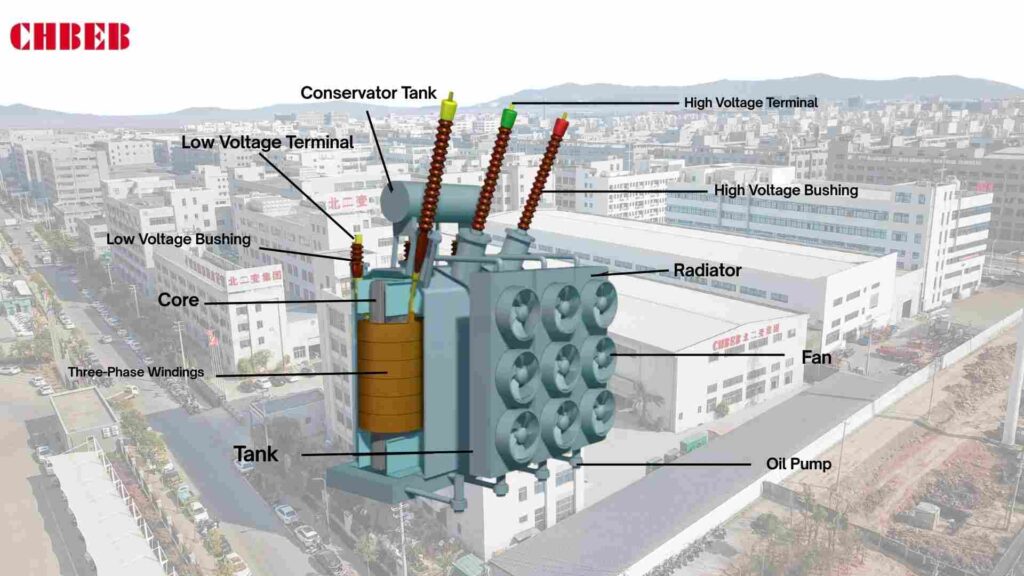
Conclusion
A power transformer is more than just copper windings inside a steel tank. Its performance depends on a careful balance of the magnetic core, windings, insulation, cooling, protective devices, and housing.
For engineers, understanding these parts means better specifications, fewer failures, and longer service life. For beginners, it’s enough to remember that every component has a role: the core carries the magnetic flow, the windings carry electricity, the insulation keeps it safe, the oil or air keeps it cool, and devices like the Buchholz relay or tap changer keep it stable and protected.
When these pieces come together with good design and proper maintenance, the result is a transformer that runs safely, efficiently, and reliably for decades—powering everything from homes and hospitals to factories and renewable plants.
- Transformer Construction — Wikipedia ↩︎
- Copper and Aluminium Windings in Transformers — ScienceDirect ↩︎
- Transformer Cooling Methods — All About Circuits ↩︎
Learn More
Want to explore more transformer solutions? Download our latest product catalog or browse our product categories to find the right transformer for your project.
Introduction
It can be hard to choose the correct dry-type transformer1 maker. Safety, technical gaps, and cost trade-offs are things that buyers often have trouble understanding. This book looks at industry trends, the best worldwide suppliers, and the most important factors to consider when choosing a partner for your project.
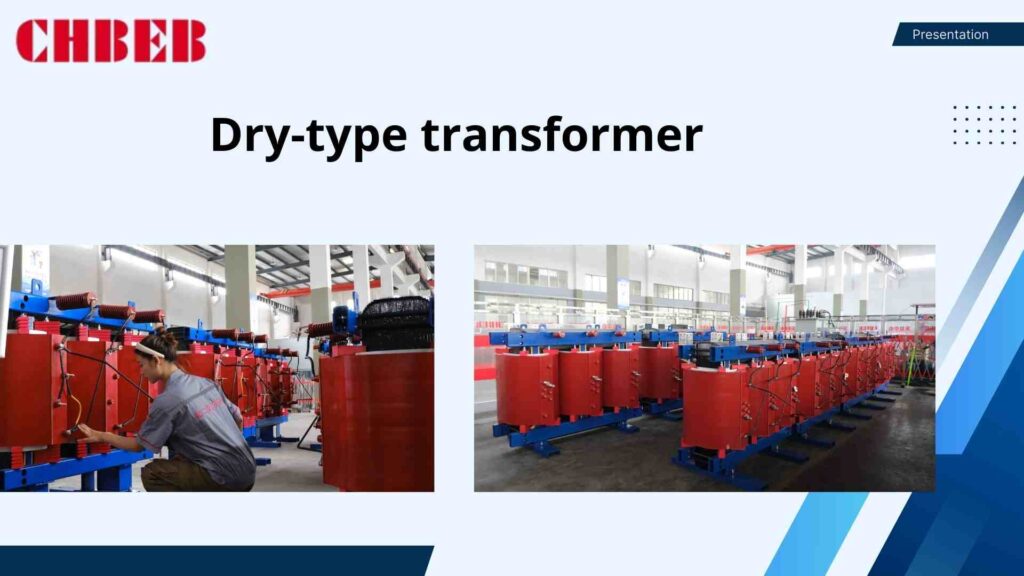
Part 1: An Overview of the Market and Its Main Technologies
When you don’t have any context, you have to guess when you make a purchase. A lot of people don’t know why dry-type transformers are becoming more popular. By looking at the factors that drive the market and the differences in technology, you can be sure that your selections are in line with the needs of your project and that your investment will last.
Why Dry-Type Transformers Are Becoming More Popular: Safety, the Environment, and Key Drivers
People are choosing dry-type transformers more and more because they are naturally safe from fire, good for the environment, and work well indoors. Key factors are:
- Safety: No flammable liquid, lower fire danger, great for places with a lot of people.
- No oil leaks, less maintenance, and recyclable materials are good for the environment.
- Urbanization: More and more hospitals, schools, malls, data centers, and underground substations are using them.
- Regulation: Stricter fire and environmental rules make it more likely that dry-type will be used.
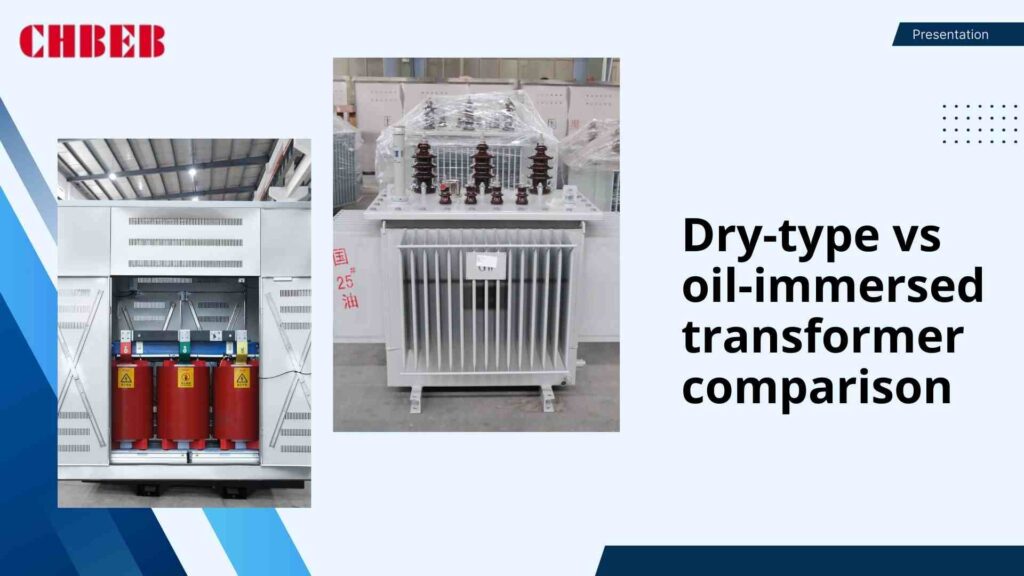
Cast Resin vs. Vacuum Pressure Impregnated (VPI)2: A Technology Showdown
There are two main technologies that rule the dry-type market:
- Cast Resin: Windings are wrapped in epoxy resin, which makes them very strong and resistant to moisture. This type of resin is good for humid or coastal areas.
- VPI (Vacuum Pressure Impregnated): Windings that have been soaked in varnish under vacuum and pressure. They are flexible, cost-effective, and can handle more thermal cycling.
It depends on the environment, the load profile, and the project’s priorities which one to use.
Part 2: Profiles of the World’s Best Manufacturers
Buyers risk making bad partnerships if they don’t know what each provider is good at. By looking at the best players, you’ll have a better idea of who is best at digitalization, heavy industry, or infrastructure. This will make sure that your project gets the proper competence.
Schneider Electric: The First Company to Use Digital Technology and Smart Grids
Schneider Electric is the best at putting dry-type transformers into digital systems. Their EcoStruxure™ technology lets you keep an eye on things in real time, plan maintenance ahead of time, and save energy. They are a great alternative for digital-ready projects because they are well-known in data centers, commercial buildings, and smart buildings.
ABB (Hitachi Energy): The World’s Biggest Utility and Heavy Industry Company
ABB, which is now part of Hitachi Energy, is the best at doing large industry and utility-scale work. Their cast-resin and VPI designs are very sturdy and work well in difficult industrial environments, high power settings, and situations where renewable energy is used. Global service networks make sure that help is available in practically every corner of the world.
Siemens Energy: The Industry & Infrastructure Expert
Siemens Energy works on infrastructure, industrial automation, and making sure that energy is always available. Their dry-type transformers have superior insulation, minimal losses, and small footprints. They are good for infrastructure and transportation projects since they can be customized and have engineering support.
Other Important Global Suppliers
- Eaton: Makes adaptable VPI designs for businesses and factories.
- Toshiba: Known for being reliable throughout Asia-Pacific and in projects with a lot of infrastructure.
- Daelim is a developing player that focuses on exports and offers reasonable prices.
- Local champions: Suppliers in the area often offer affordable solutions that meet local codes.
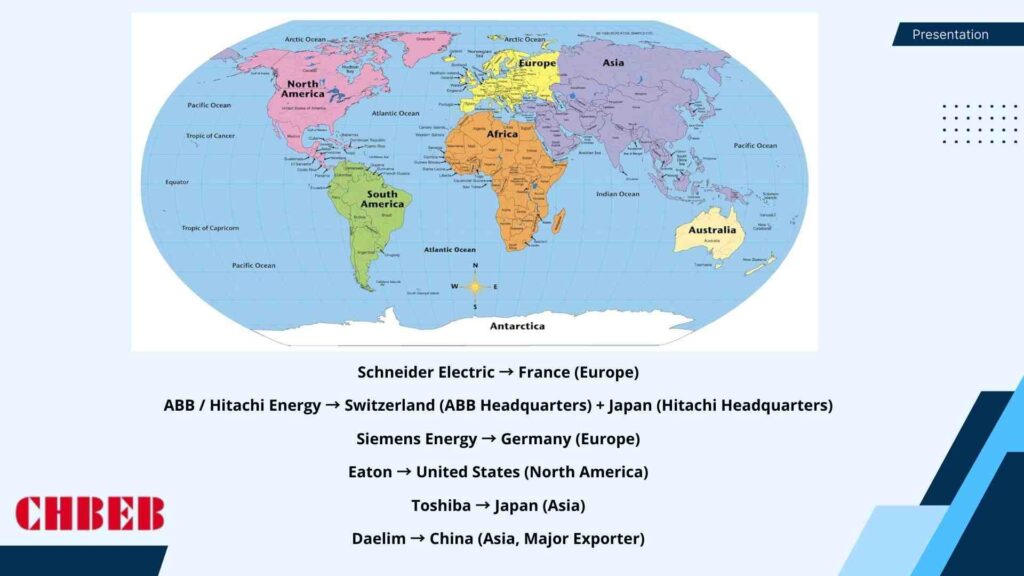
Part 3: Comparative Analysis & Purchasing Strategy
Just looking at the price doesn’t tell you how much anything is worth. A lot of purchasers don’t think about service, lifecycle expenses, or vendor stability. A organized comparison makes sure you get not just the equipment you need, but also dependable help and savings over time.
Multi-Dimensional Comparison: Product, Service, and Market Position
| Manufacturer | Technology Focus | Market Strength | Best Fit |
|---|---|---|---|
| Schneider Electric | Cast Resin, Digital Integration | Strong in smart buildings & data centers | Digital-ready, efficiency-focused projects |
| ABB / Hitachi Energy | Cast Resin & VPI | Utility & heavy industry | Large-scale renewables, utility grids |
| Siemens Energy | Cast Resin | Infrastructure & transport | Industrial, transport, infrastructure |
| Others (Eaton, Toshiba, Daelim) | VPI & Cast Resin | Regional strength, competitive pricing | Cost-sensitive or localized projects |
How to Choose the Best Option for Your Project
- Set the kVA, voltage, environment, and fire/safety codes as required.
- Check out the technology: Cast Resin vs. VPI for load and climate.
- Look at the costs over the life of the product, including losses, maintenance, and downtime concerns.
- Check the vendor’s support: is it available globally or only in certain areas?
- Make sure that the certifications IEC, IEEE/ANSI, CE, and UL are all up to date.
- Think about customization: special enclosures, noise, and monitoring.
To get the most out of your dry-type transformer investment, you need to be sure that it fits technically, is compliant, and is from a reliable source.
Conclusion
Safety, sustainability, and digital integration are shaping the global market for dry-type transformers. Well-known manufacturers like Schneider Electric, ABB/Hitachi Energy, and Siemens Energy set high benchmarks in technology, certification, and worldwide service networks, making them the preferred choice for utility-scale, industrial, and infrastructure projects.
At the same time, regional and local manufacturers also play a vital role. They often provide faster delivery, competitive pricing, and flexible customization that global giants may not always offer. For projects in emerging markets or with unique requirements, these manufacturers can deliver reliable, efficient, and standards-compliant solutions tailored to local conditions.
As Nikola Tesla once said, The spread of electricity will do more to improve life on earth than any other single advance.
In the same spirit, whether from a global leader or a trusted regional supplier, dry-type transformers remain essential to powering communities safely, sustainably, and reliably for decades.
Learn More
Looking for the right dry-type transformer for your project? Download our latest product catalog or browse our product categories to find reliable solutions tailored to your needs.
Introduction
Standard transformers often don’t meet important needs. The outcome is extra effort, lost time, and money. Custom 11–35 kV step-up transformers fix voltages, footprints, and duties that aren’t conventional. They make connections safer, work more efficiently, and cost the least over the life of the project.
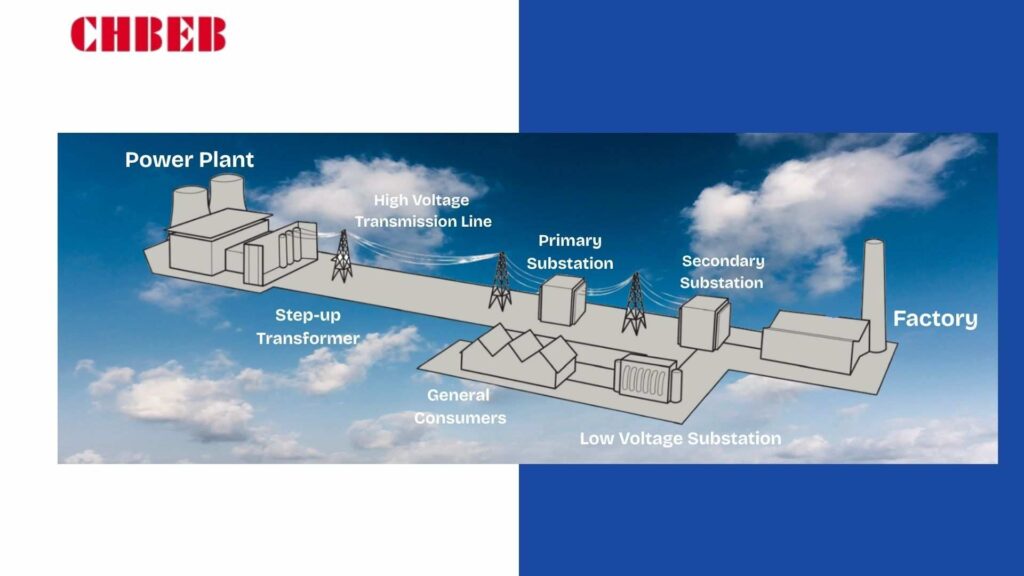
Why Get a Custom Transformer? The Value Proposition
Off-the-shelf systems have trouble with strange voltages, limited space, and environmental dangers. These gaps lead to change orders and time off work. Custom engineering makes sure that electrical, mechanical, and compliance demands are all met from the start. This lowers risk, boosts performance, and protects budgets for decades.
Finding solutions to power and space problems that aren’t standard
Instead of making the site fit the transformer, custom designs take into account real-world limitations. Some of the problems we solve are:
- Hybrid systems, specialized phase shifts, neutral availability, and grounding techniques are all examples of non-standard voltages and vector groups
- Tight footprints and weight limits: small tanks, low-profile radiators, or split modules for pads and rooftops that don’t have a lot of space.
- Extreme environments: Marine-grade coatings (C5-M)1, sealed bushings, wildlife guards, sand/salt mitigation, and cores that don’t make a lot of noise.
- Grid-code details: Tap ranges (±2×2.5% or wider), impedance targets, BIL coordination, and pairing of arresters.
- Operational limits include high altitudes, high ramp rates, frequent cycling, and harmonics from VFDs or inverters.
Getting the best performance and lowest total cost of ownership (TCO)

The cheapest up front isn’t always the cheapest to own. Customization lowers losses, makes insulation last longer, and stops outages. Make money off of savings:
- Loss packages: Make sure there are no assured losses while the load is on or off. A few hundred watts saved running 24/7 for decades.
- Thermal design: ONAN/ONAF stages, RTDs, and hotspot control to keep insulation from breaking down while ramping and cycling.
- Serviceability: standard bushings and elbows, easy access to taps, and spare parts kits reduce down on MTTR and labor.
- Natural ester can be a better alternative for fire protection and the environment than mineral oil2.
Making Your Own Solution: Oil-Immersed or Dry-Type
Choosing the improper construction might lead to safety issues or inefficiencies. The rules and duties for each site are different. Pick the dielectric and enclosure that meet your fire strategy, environment, and lifespan goals to prevent having to rework them later.
Custom Oil-Immersed Transformers: The Best Choice for Power and Longevity
Oil-immersed designs work best outside and at higher kVA levels since they take up less space and have significant thermal inertia. You can choose from the following:
- Voltage systems: from 0.48 to 1.0 kV for LV and from 11 to 35 kV for MV; Dyn/YNd groups per grid code.
- Cooling: ONAN base with ONAF fans and ducts for oil to flow to hotspots.
- Loss targets: Optimized core/winding geometry and high-quality steel to stay within the loss caps set by the tender.
- Mineral oil is cheap, and natural ester has a high fire point and breaks down naturally.
- Mechanical: Low-noise clamps, vibration isolators, and corrosion systems for sites along the ocean or in the desert.
Best for utility yards, collecting renewable energy, heavy industrial work, and projects that put a high value on efficiency and overload margin.
Custom Dry-Type Transformers: For Safety and Special Situations
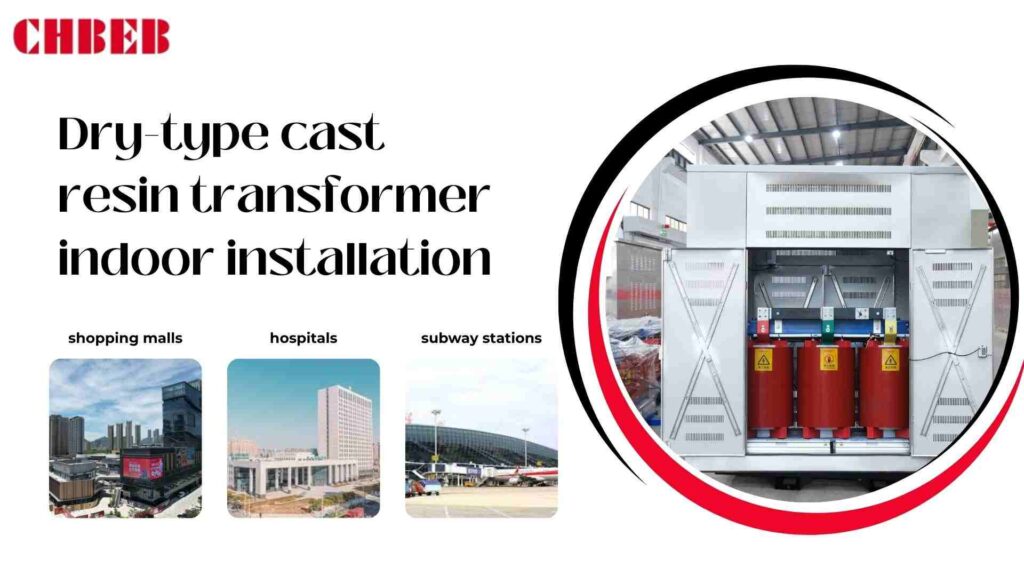
Dry-type (VPI/cast resin)3 works best when liquids are limited or when you need to set up quickly indoors. Some of the things you can change are:
- Ingress and ventilation: Enclosures with filtered airflow, IP ratings, and cooling routes that go where they need to go.
- Fire and smoke profile: Cast-resin systems that work well in tunnels, hospitals, transit systems, and high-rise basements.
- Acoustics: Quiet zones with low-flux-density cores, dampening kits, and enclosure liners.
- Form factor: Doors, lifts, and mezzanines have height and width limits, and the components can be put together in different ways.
Perfect for malls, universities, data-adjacent rooms, and areas where liquids are not allowed.
The Steps: Getting an Estimate for Your Custom Transformer
Unclear RFQs lead to delays and modification orders. Clear, engineering-ready briefs speed up pricing, approvals, and delivery, which lowers project risk and total cost.
A checklist for success with your custom design brief
To get quick and accurate quotes, please give the following:
- Electrical: kVA, LV/HV voltages, vector group, goal %Z, tap range, short-circuit levels, and how to ground it.
- Load profile: duty cycle, ramps, overload limits, harmonics limitations, and the existence of an inverter or VFD.
- Environment: indoor/outdoor, ambient/altitude, corrosion category, dust/salt, animal concerns, and noise limits.
- Protection: Bayonet/CL fuses, MV surge arresters, PRV/RPRR, relays, and fault indicators.
- Compliance: IEC 60076 / IEEE C57, CE/UL needs4, type/special tests, and witness testing.
- Mechanical and logistics: maximum footprint, height, and weight; lifting paths; pad specifics; delivery access; and required ship date.
- Operations: spare parts kit, paperwork set, warranty expectations, and monitoring (RTDs, oil/moisture sensors).
Our Customization Process: From Idea to Delivery
- Discovery and scoping: Make sure you know your responsibilities, the environment, and the rules. Also, set success measures like losses, noise, and footprint.
- Thermal, electrical, and mechanical models; preliminary GA drawings; and forecasts of loss and efficiency are all part of pre-engineering.
- Quotation and TCO: Itemized prices with alternatives (copper vs. aluminum, ester vs. mineral oil) and loss capitalization.
- Design freeze: Final drawings, tap settings, protection, coatings; factory test plan agreed.
- Manufacture and FAT: routine and type testing according to standards; optional witness; shipping preparation and preservation.
- Delivery and SAT include site checks, terminations, commissioning tests, baseline thermography, and handing over documents.
- After the sale: spare parts, monitoring dashboards, a schedule for maintenance, and performance reports.
Conclusion
Custom 11–35 kV step-up transformers are not just special order equipment — they are the only way to align real-world site limits with strict grid requirements.
For professionals
Customization ensures that electrical parameters (kVA rating, impedance, vector group), thermal design, and compliance certifications are precisely matched to project needs. This reduces risk, avoids costly redesigns, and secures the lowest Total Cost of Ownership (TCO) across decades of operation.
For beginners
Think of it like tailor-made shoes. Standard shoes may pinch or feel loose, and problems show up over time. A custom-made pair costs a bit more upfront but delivers comfort, durability, and peace of mind. In the same way, a custom transformer designed for your site keeps power reliable, safe, and efficient.
In short: By defining clear requirements, selecting the right materials, preparing a structured RFQ, and applying TCO thinking, you secure more than a transformer — you gain a long-term guarantee of safety, efficiency, and reliable power.
- Corrosion categories and protective coatings — ScienceDirect ↩︎
- Natural Ester Dielectric Fluid for Transformers — IEEE Xplore ↩︎
- Dry-type transformer — Wikipedia ↩︎
- IEC 60076 Power Transformer Standards — IEC ↩︎
Learn More
Want to explore more transformer solutions? Download our latest product catalog or browse our product categories to find the right transformer for your project.
Free CHBEB Transformer Catalog Download
Get the full range of CHBEB transformers in one catalog.
Includes oil-immersed, dry-type, pad-mounted, and custom solutions.
Quick Message
Request A free quote
We'd like to work with you
- +86 15558785111
- chbebgroup@chbebpower.com
- +86 15558785111
What We Do
CHINA BEI ER BIAN (CHBEB) GROUP, with 218 million in registered capital, originated from Beijing Beierbian Transformer Group. Headquartered in Beijing for R&D, it operates major production bases in Nanjing and Yueqing, producing high-quality products.
Latest Product
address
BeiJing
No 3,RongJing East Road,BeiJing Economic Technological Development Area,BeiJing,China
JiangSu
No 7️Xiangfeng Road,Jiangning,NanJing,JiangSu,China
WenZhou
No.211, Wei 16 Road, Industrial Zone, Yueqing, Wenzhou, Zhejiang, China.
XiangYang Industrial Zone ,YueQing,WenZhou,ZheJiang,China
contact us
- chbebgroup@chbebpower.com
- +86 13057780111
- +86 13057780111
- +86 15558785111
Copyright © Bei Er Bian Group


